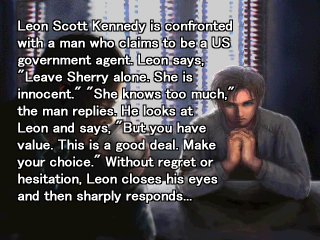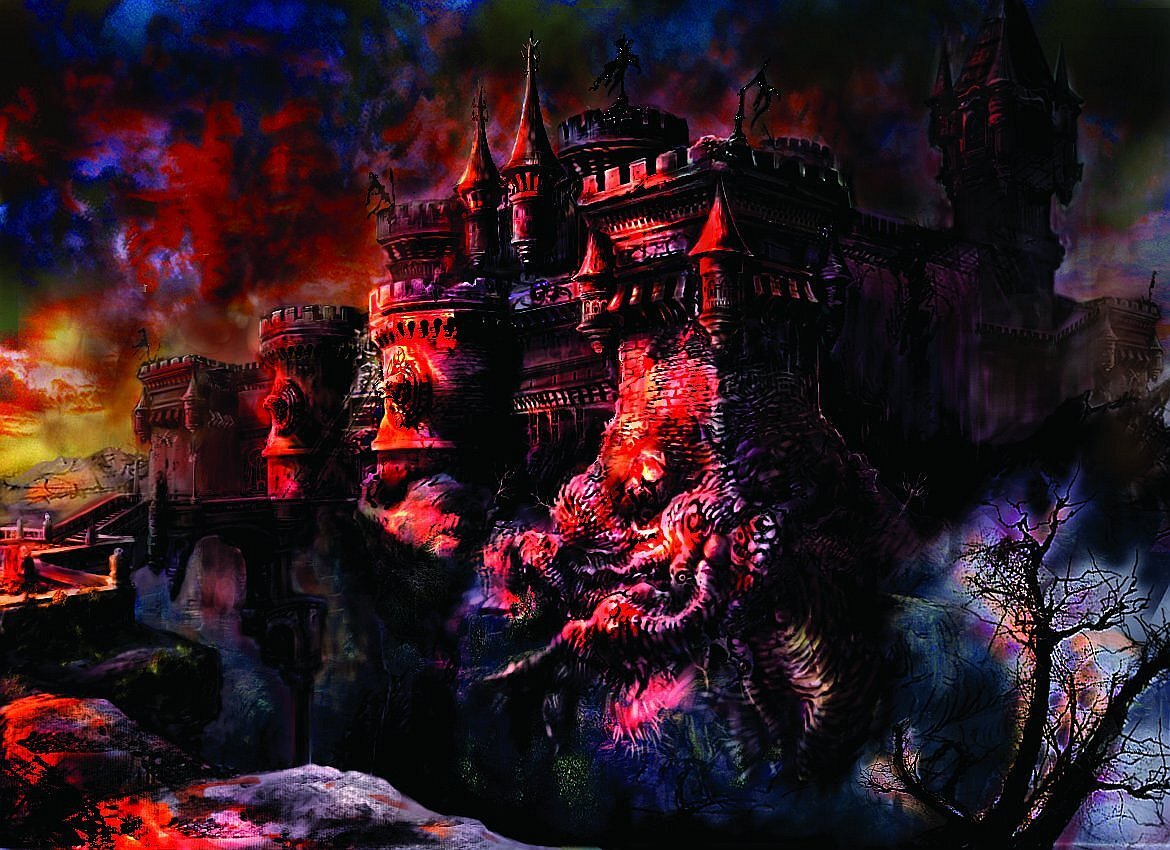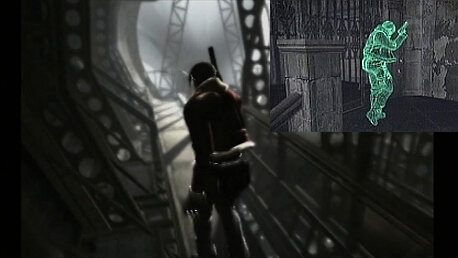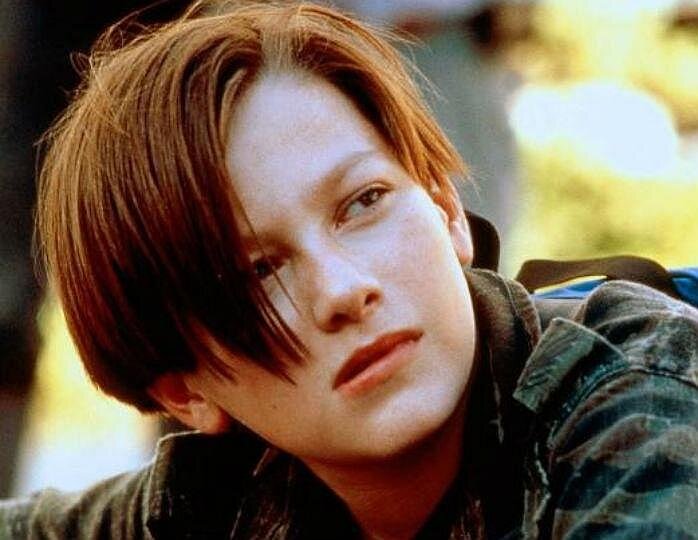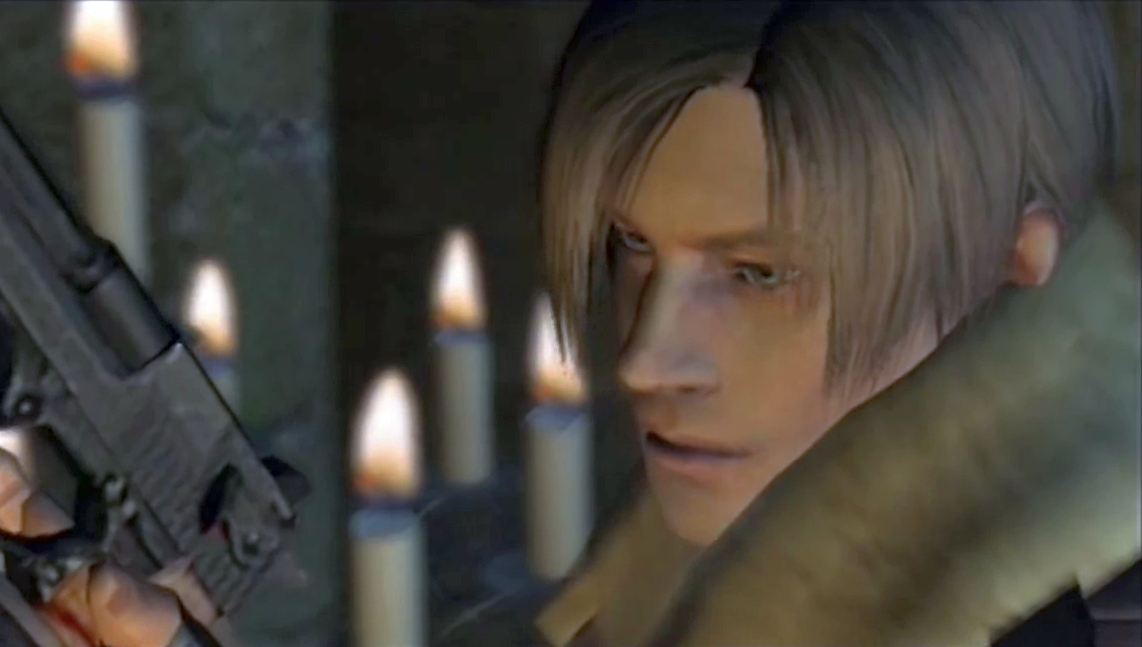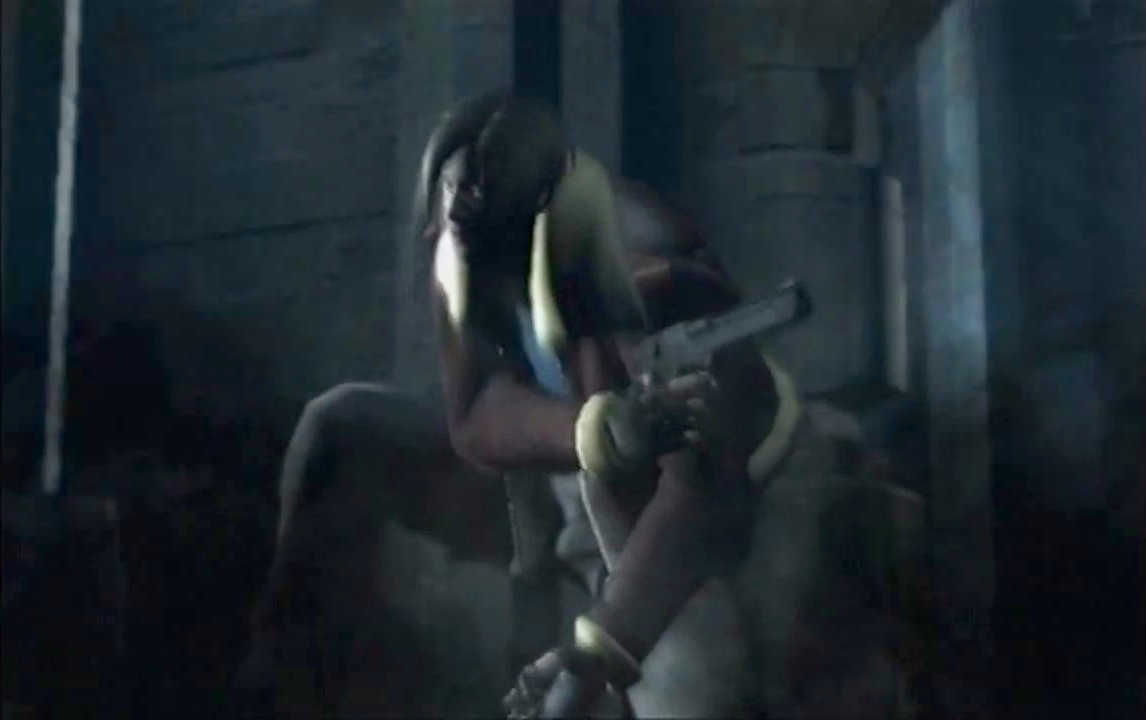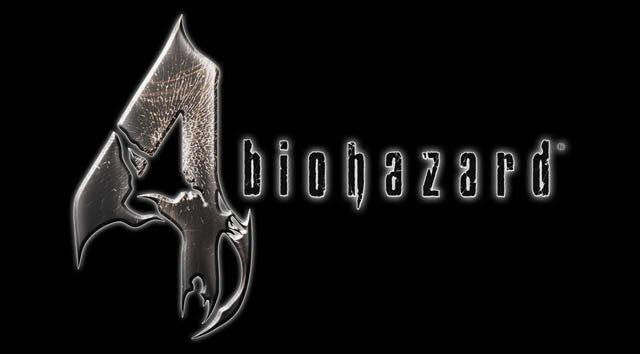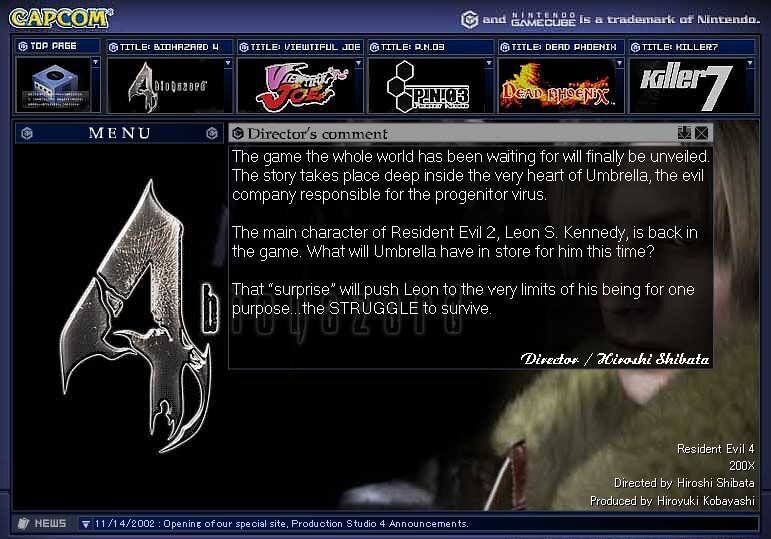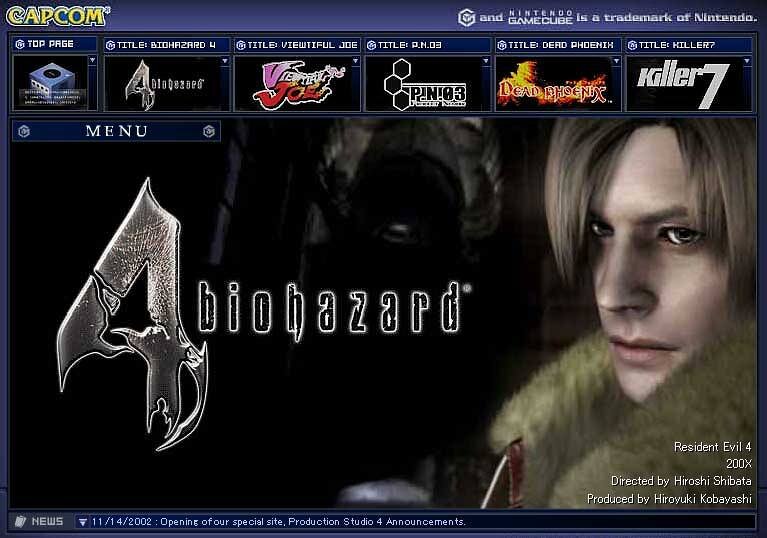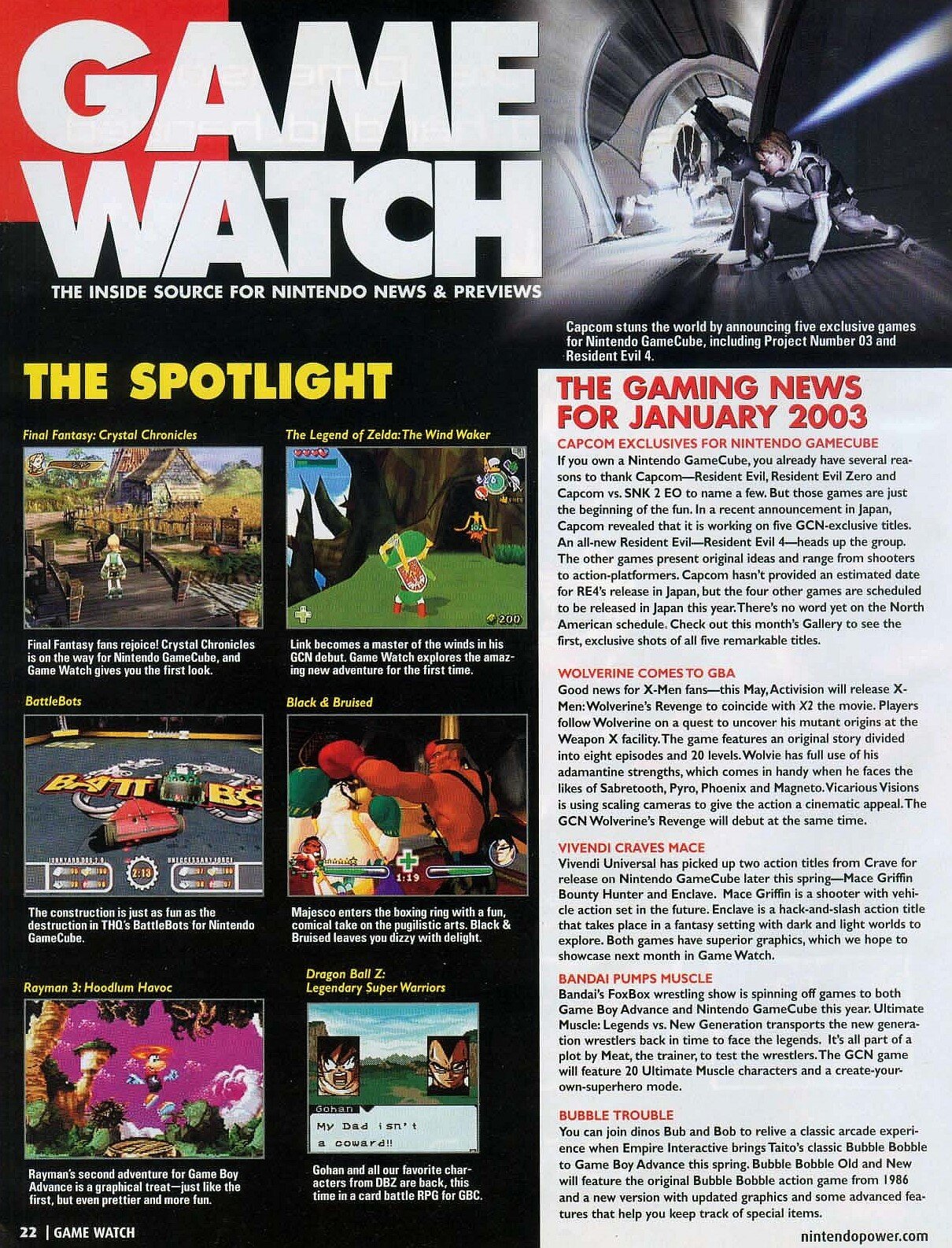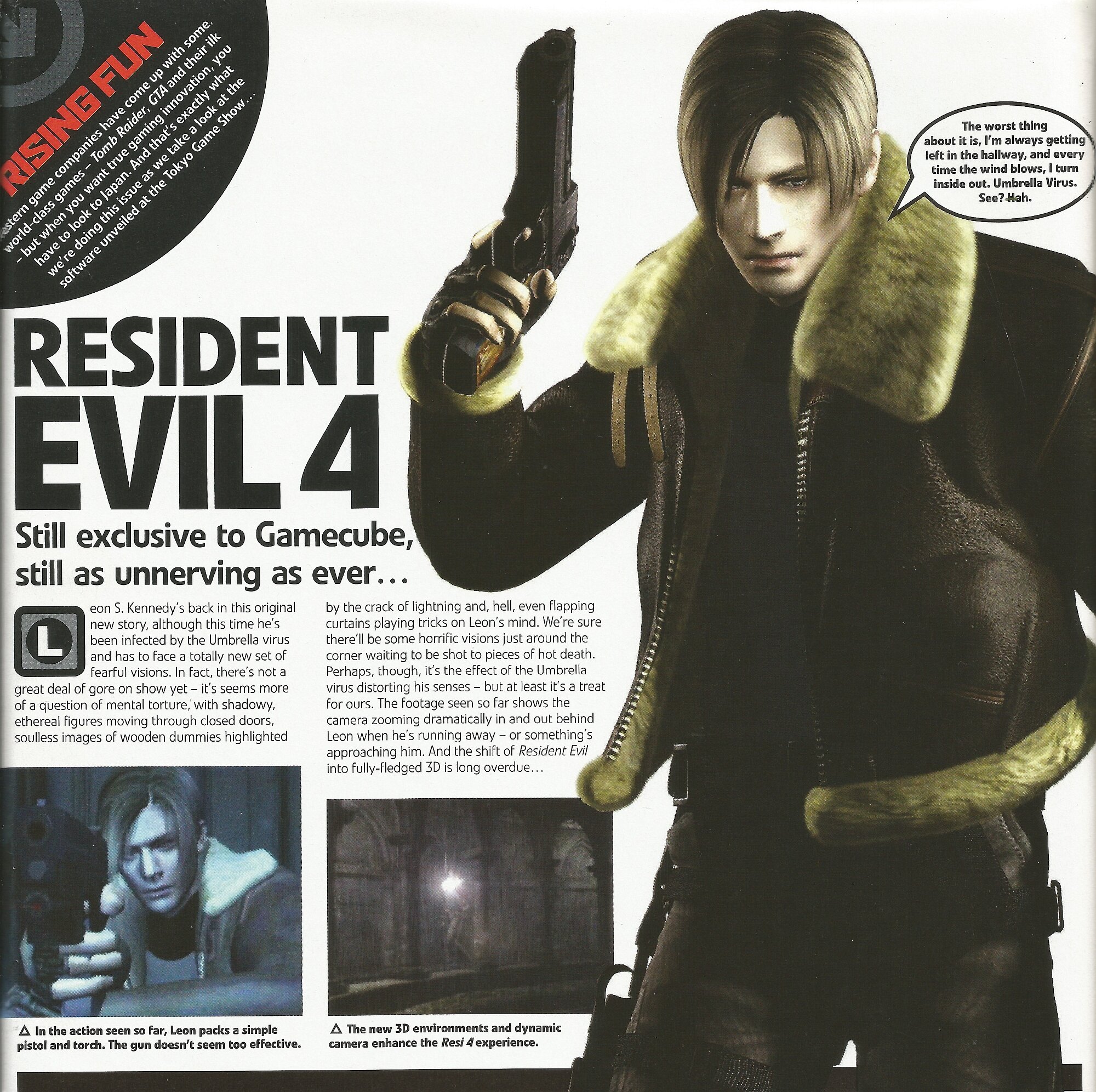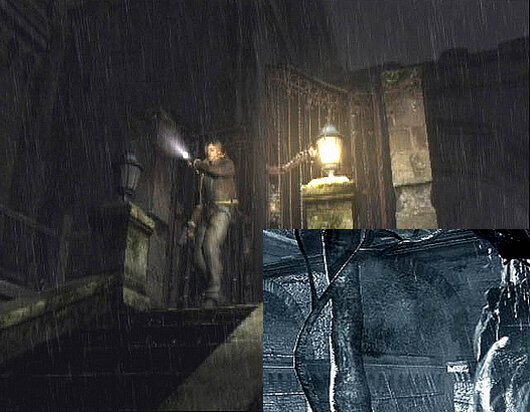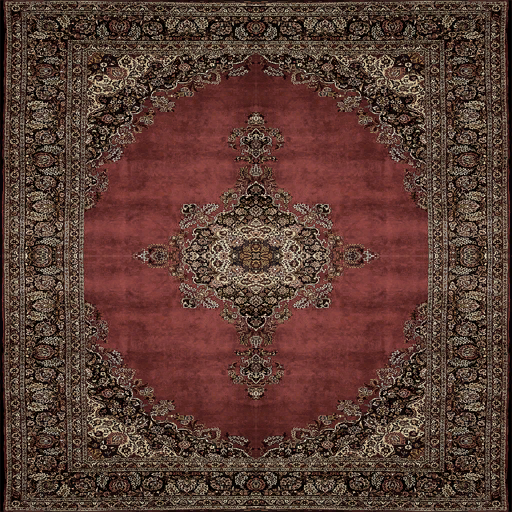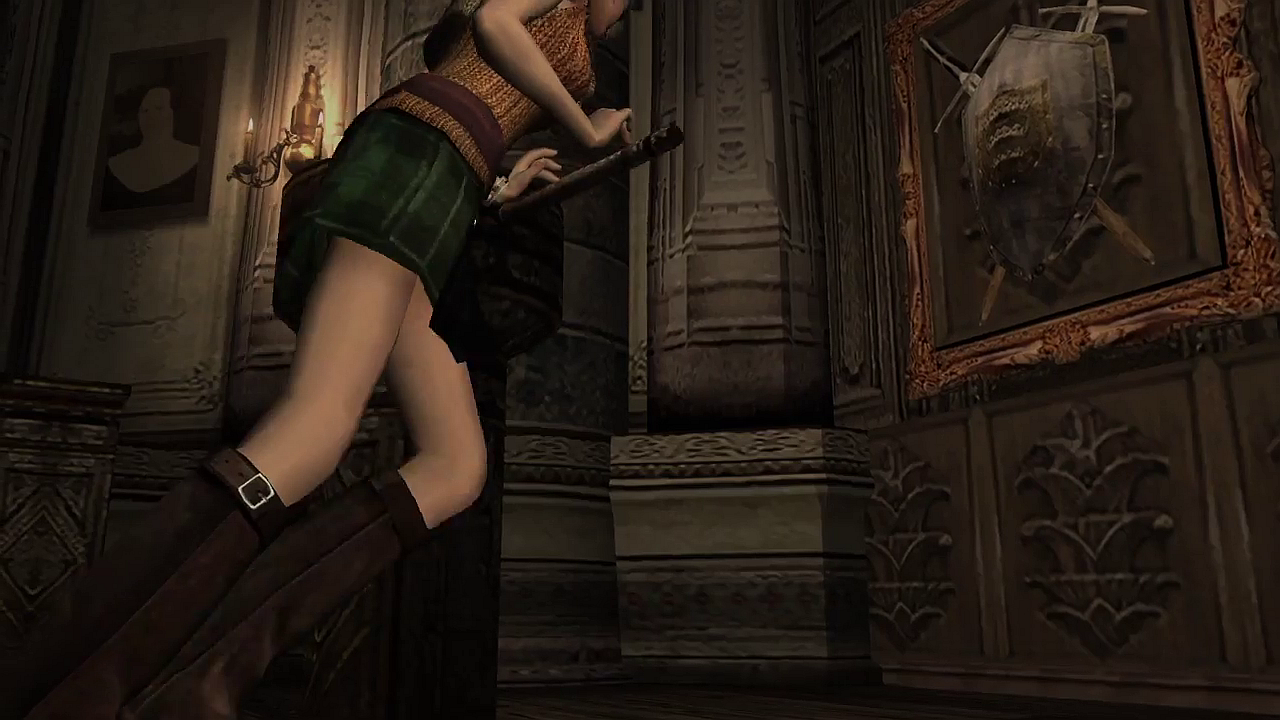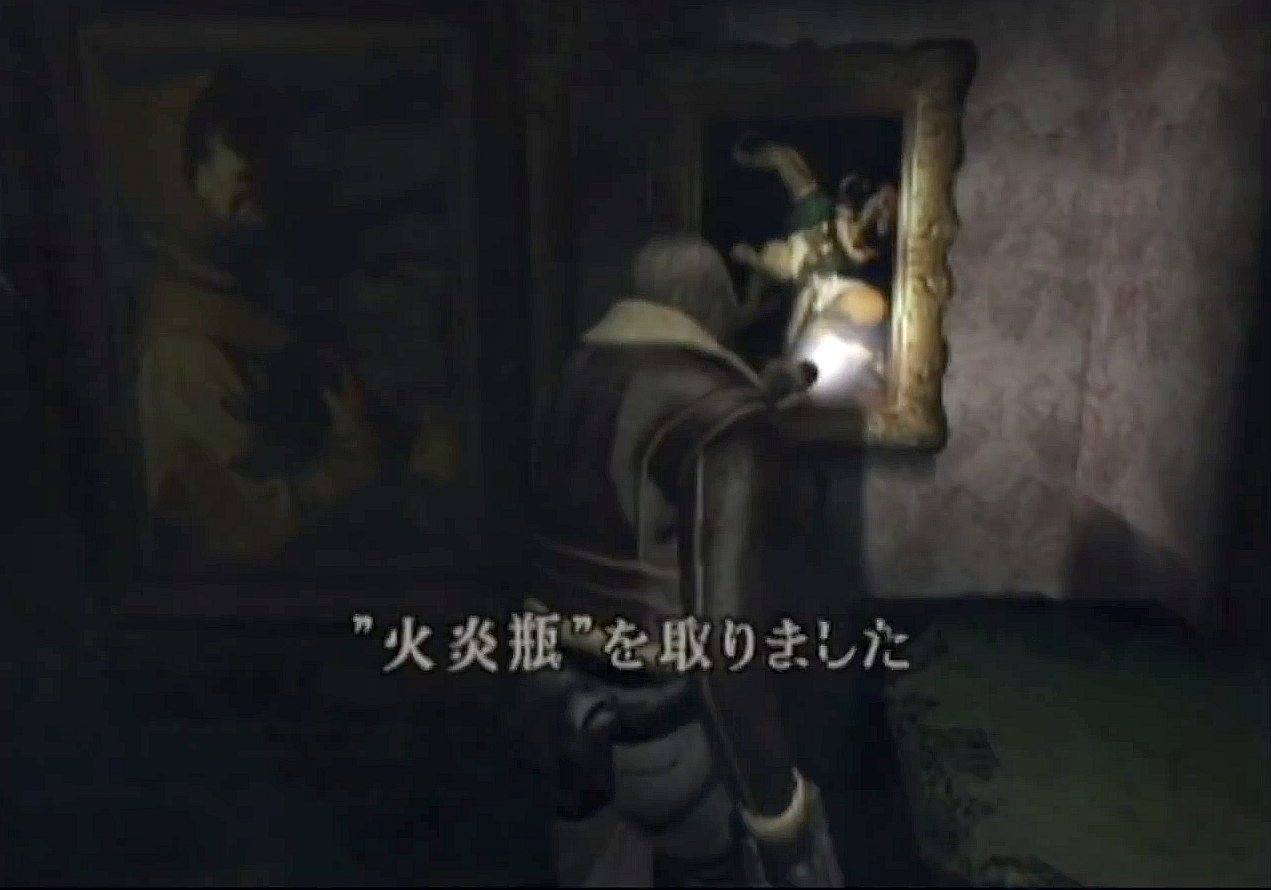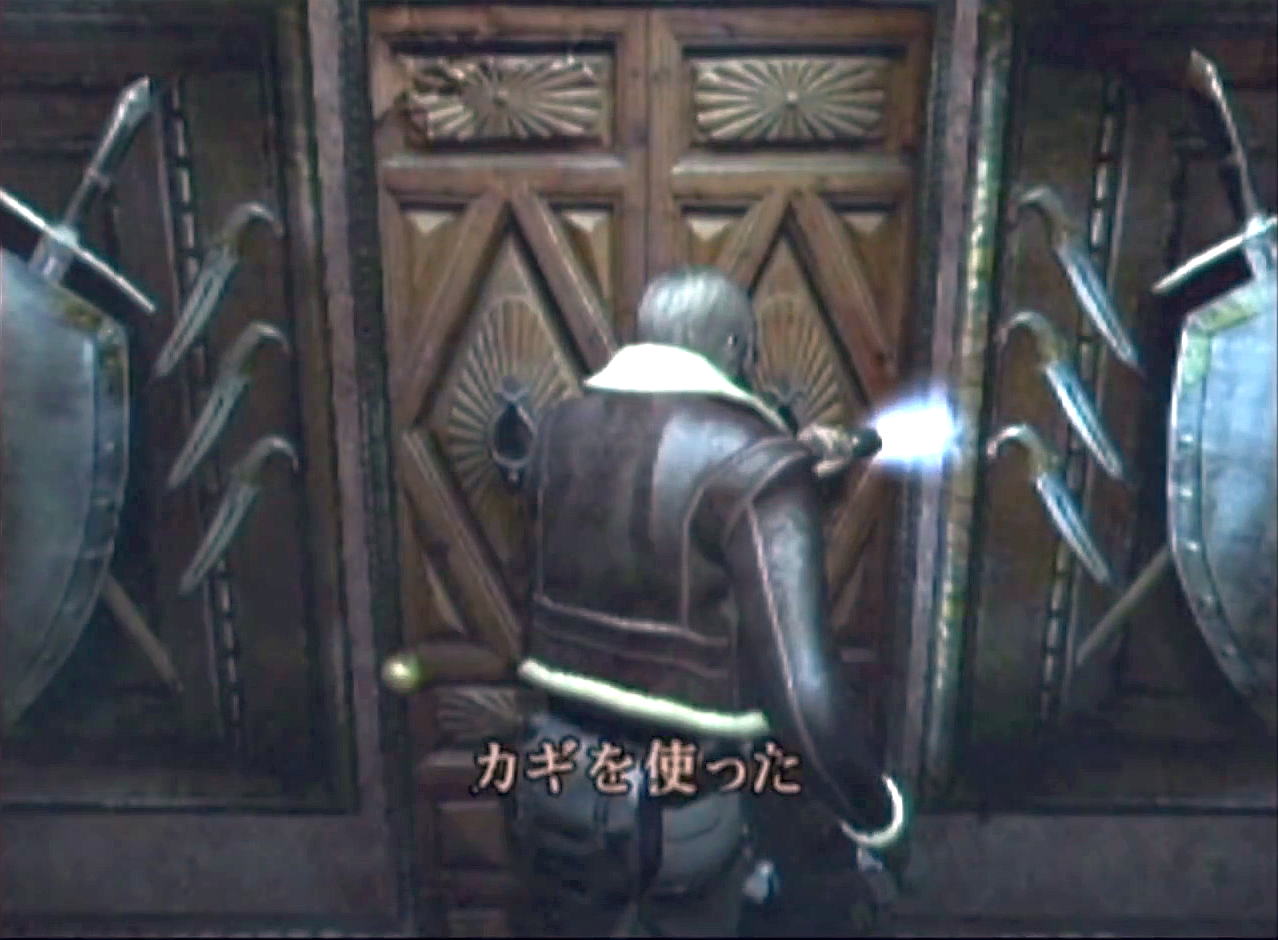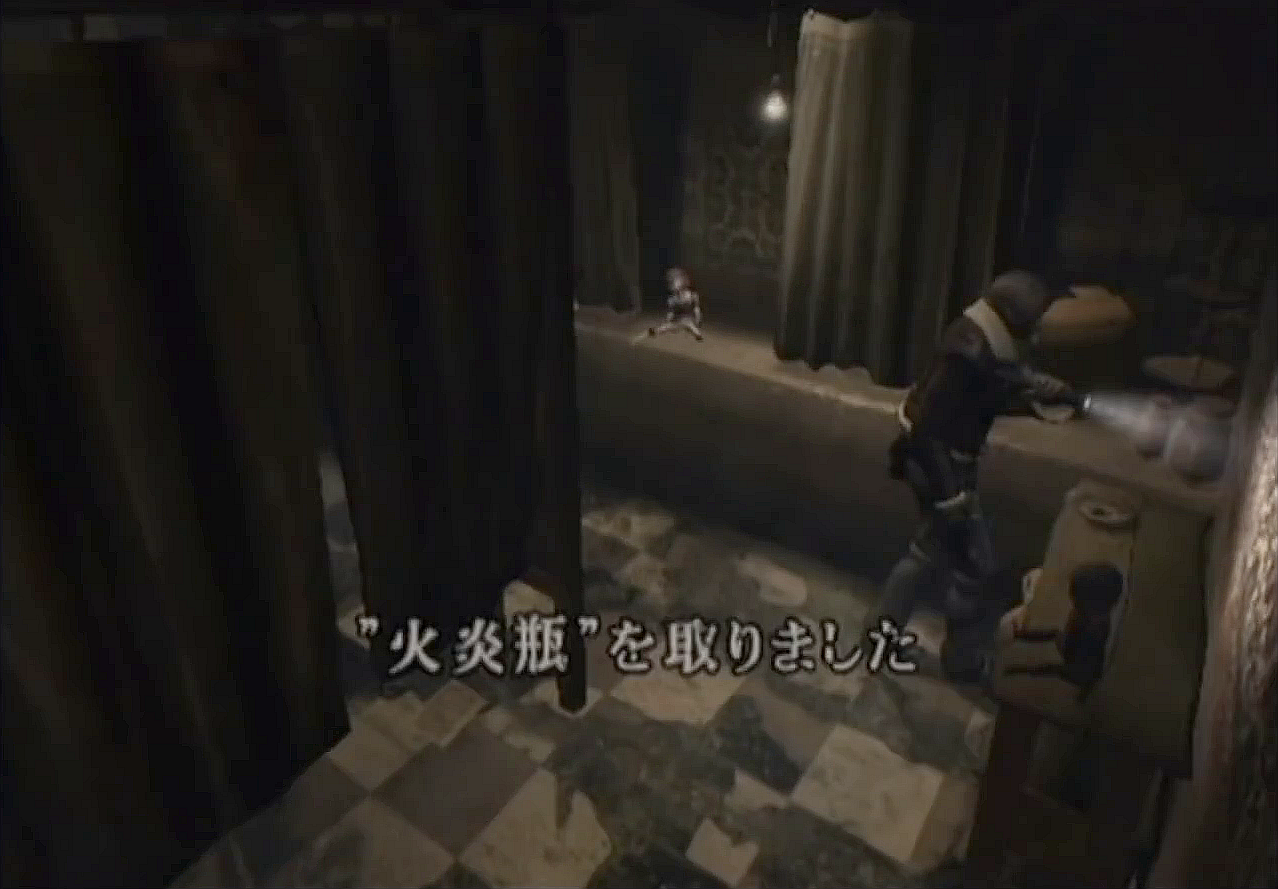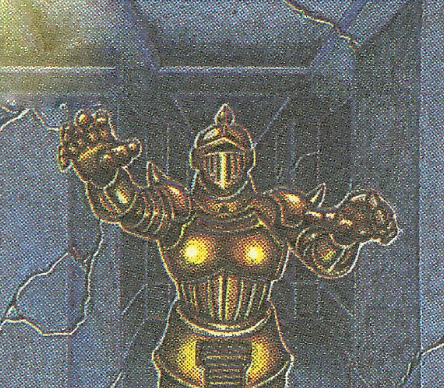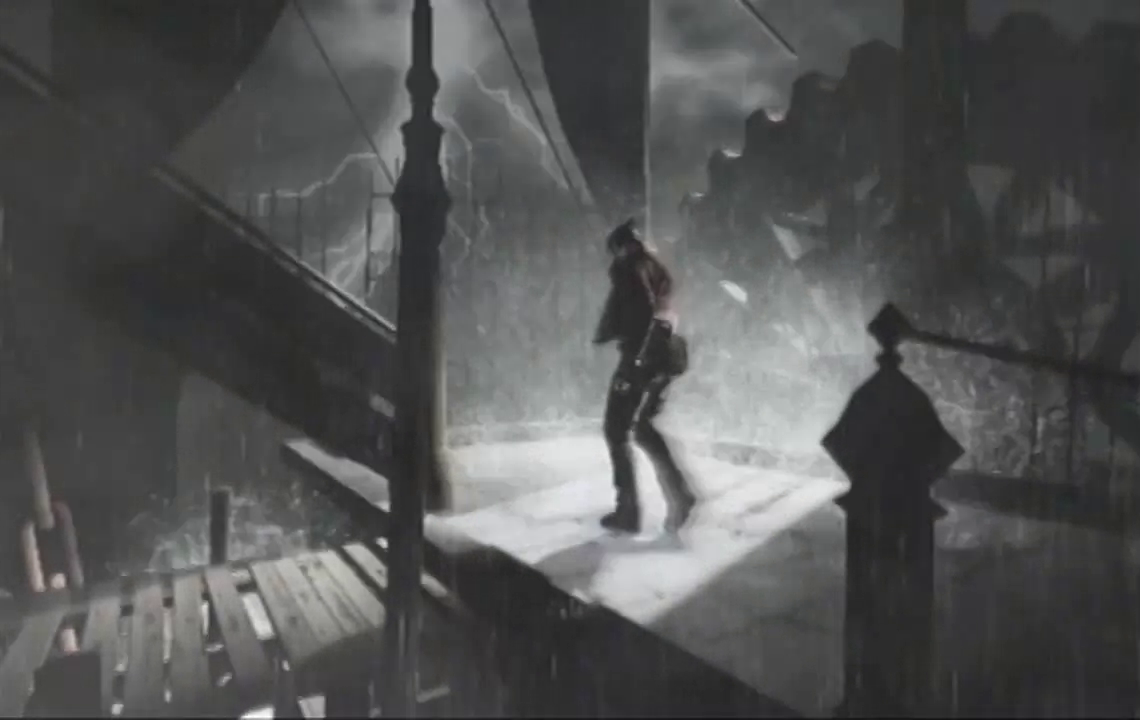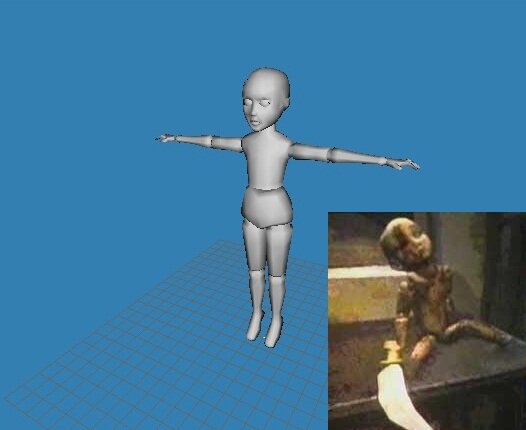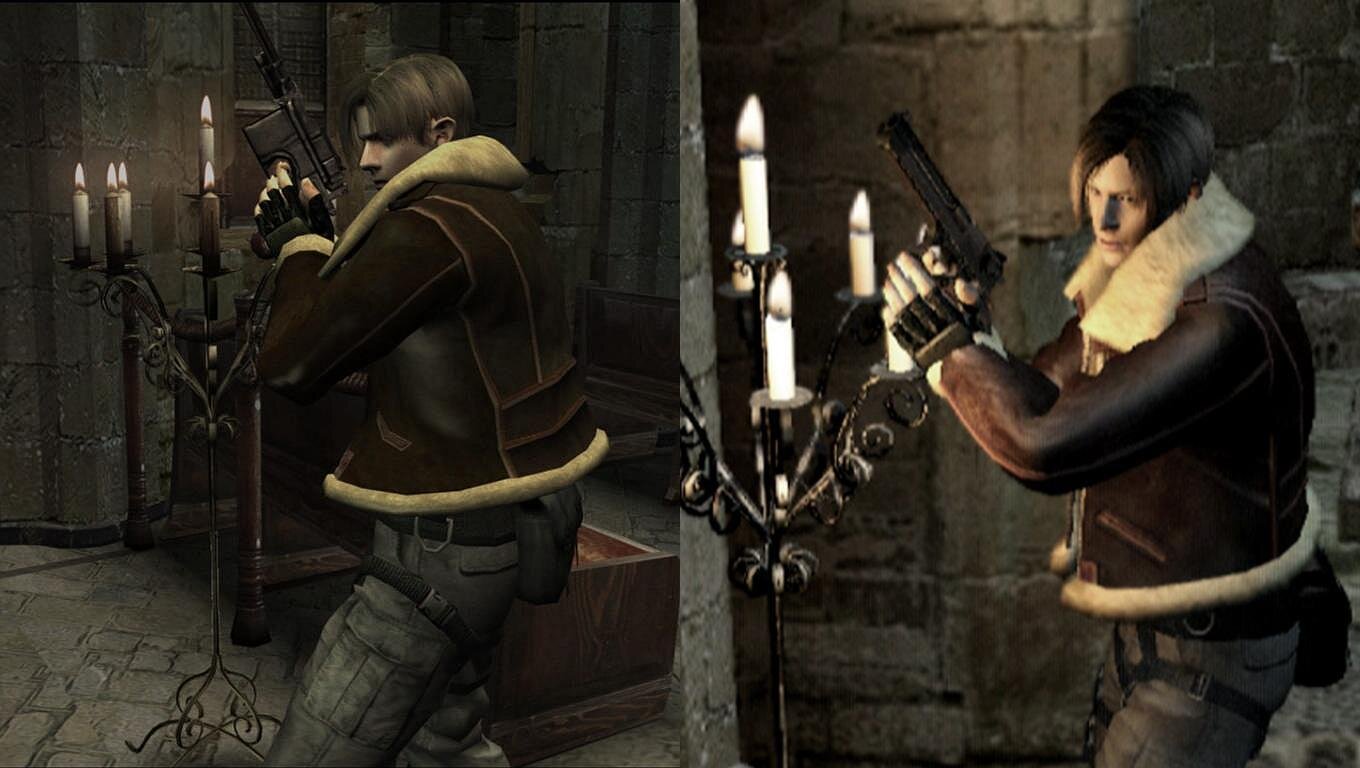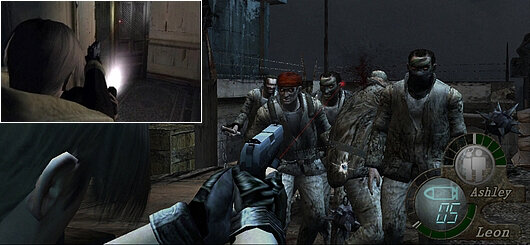
Article researching Yasuhisa Kawamura’s Resident Evil 4 beta ‘Hookman/Hallucination’ experimental game-play & ‘Castle/Fog’ scenario, known collectively as ‘biohazard 3.5’
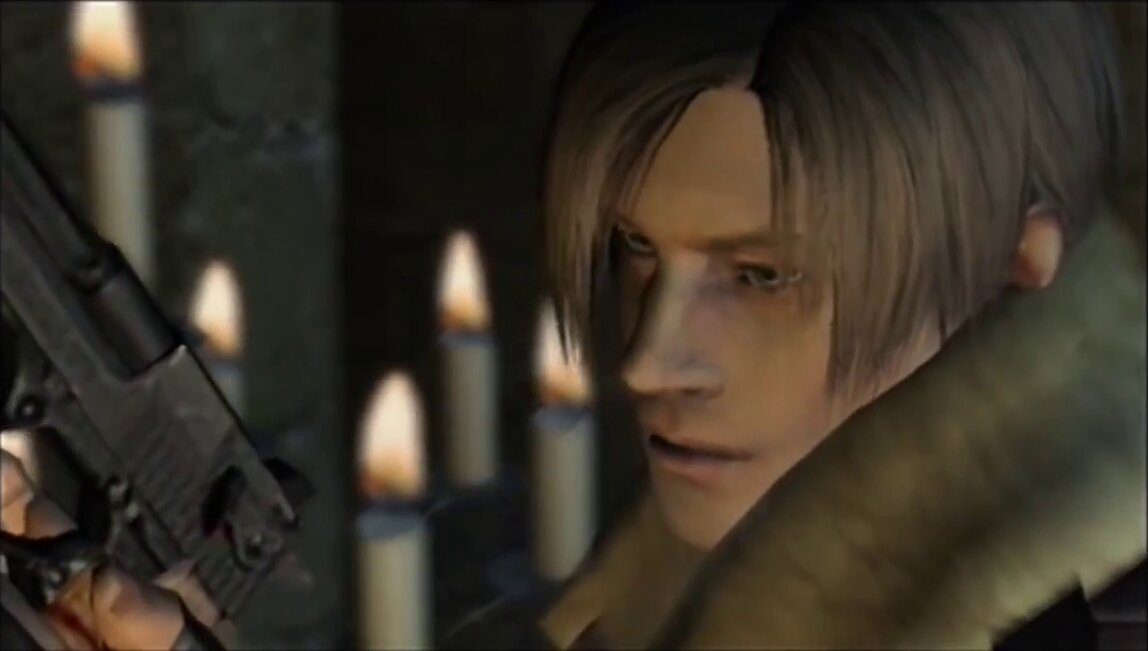
biohazard 3.5
More than any other title in the series before it and since, biohazard 4 has had by far the most tortuous, protracted development history. By the start of 2005, when the completed retail version was eventually released, three previous beta builds, and one game-play experiment had come and gone, all discarded before producer Hiroyuki Kobayashi could finally give satisfied approval to a build worthy to develop into the retail article…
The earliest beta build commissioned to carry the biohazard 4 title was initiated as far back as 1998, as a PlayStation 2 exclusive; at the helm Resident Evil 2 director Hideki Kamiya. The first public confirmation of this was at the end of 1999, at ‘Capcom Gamers Day’, in Las Vegas, with Shinji Mikami confirming in his producer profile that a Resident Evil sequel was in the works for PlayStation 2: Resident Evil Series to Haunt PlayStation 2
JANUARY 2000: Regular series writer Noboru Sugimura developed a scenario formulated from Kamiya's concept to create "cool" & "stylish" game-play. His attempts to incorporate this mission statement into the established world of biohazard concluded with the creation of a completely new titled series for Capcom, Devil May Cry, which can trace its roots back to this period:
シナリオ考案が始まったのは1年半ほど前。当時は、タイトルがまだ「バイオ4」だったので、メインテーマの“カッコ良さ”をバイオの世界観に盛り込む方向で進めました。
“About a year & a half ago the scenario was written. At that time it (Devil May Cry) was still biohazard 4. I took the project forward with a focus on the main theme of 'coolness', incorporating this into the world of biohazard.” Hideki Kamiya's Devil May Cry Column, 'Scenario Story'
「デビル メイ クライ」は当初、プレイステーション2用バイオ最新作として開発がスタートしました。
“Devil May Cry was initially conceived as the latest biohazard development for PlayStation 2.” Hideki Kamiya's Devil May Cry Column, 'New Bio'
And in exclusive interview with ProjectUmbrella.net biohazard 3.5 scenario creator & planner, Yasuhisa Kawamura, whilst explaining his team's origins, confirms this first version's journey towards a finalised retail product:
“So, the decision was made to promote the Gaiden team into the new BIOHAZARD 3 team & the staff size was significantly increased to work towards a launch on the PS1. This allowed us to release a biohazard game on a consistent schedule while providing Mr. Kamiya's team enough time to concentrate on the capabilities of the new platform. Mr. Kamiya's team was reorganized into the biohazard 4 team and was tasked with creating a top-notch game for the PS2. When BIOHAZARD 3 was finished, a large portion of that team, including myself, joined in to help. This biohazard 4 project eventually changed directions and finally saw completion as the game Devil May Cry.”
The road to this first version becoming the seed of an entirely new title, not to be discarded altogether, as was to be the fate of the proceeding two attempts & Kawamura-san's game-play experiment, effectively began when Kamiya felt the playable character in this premier biohazard 3.5 incarnation, lacked heroism, and courageous presence when presented within a fixed camera perspective; the pre-rendered backgrounds that had traditionally provided the heart for biohazard's atmosphere & design were substituted for a new dynamic camera system.
Concept art from the earliest beta scenario for biohazard 4, which deviated into becoming Devil May Cry, illustrates the main character (to become Dante), in Sir Spencer's bedroom.
Sugimura-san tried to incorporate ‘cool & stylish’ themes, but series creator Shinji Mikami was mindful that the new camera angles & narrative strayed too far from the survival horror roots that had so successfully defined biohazard, and he cajoled the development team into exploiting departure from the traditional style, by severing all ties with biohazard, in favour of a new independent title (E3 2001 Interview with Shinji Mikami). Kamiya consequently changed the protagonist name to Dante, placed him in a new narrative based on a demonic world, and so in August 2001, Devil May Cry was born (Hideki Kamiya's Devil May Cry Column, 'Scenario Story').
The next version planned to hopefully provide a beta build that would develop into biohazard 4 suitable for retail, would have to focus more awareness on and appreciation for the closing timeline events, if that goal was to be achieved.
The Resident Evil 2 prologue claims that the events from Resident Evil were only a mere fraction of Umbrella's great evil, but conversely biohazard 4 was always planned by Shinji Mikami to herald the death knell for Umbrella. Despite initial murmurings amongst some of the more sensationalist gamer press, biohazard 4 was never intended to be the end of the series as a whole, just the end for Umbrella. Mikami-san was surely mindful that Umbrella would need to be consigned to biohazard’s history, if Capcom were to successfully progress the series forward, into a new generation for gamers who had moved on from pre-rendered backgrounds, and static camera angles.
“It’s time for us to DESTROY Umbrella!”
The next biohazard 4 era commenced with the continuation of Leon's narrative; similarly to Resident Evil Code: Veronica covering the continuation of Claire's story. Hence the ending of Resident Evil 2, with Leon's mission statement, is the point at which Resident Evil 4's narrative was to commence; the specific theme being Leon's determination to end the cancer that was Umbrella, and his Resident Evil 2 final words would be the first steps on the road to the corporation's end. (English dialogue: “Hey, it's up to us to take out Umbrella!” / Japanese subtitle translation: “Destroy Umbrella!”)
In 2001, Resident Evil 2 director, Hideki Kamiya, confirmed this on the Japanese Devil May Cry website, in the storyboard section:
「バイオ 2」のエンディングでもそうですが、続きを思わせるような、さりげない余韻を 残すのが僕は好きなんです。「ダンテとトリッシュ、二人でデビルハンターを続けてるみたいだけど、敵は誰なの? 二人の関係は?」なんて、いろいろ想像できて楽しいじゃないですか。でもバイオ2の時は、シナリオにないセリフをレコーディング現場で勝手に足して、クレ アは兄を探しに、レオンはアンブレラをぶっ潰しに行く事にしてしまったので、その後の「CODE:ベロニカ」のシナリオにも影響を及ぼし、フラグシップの 杉村先生にこっぴどく叱られました…。
“Although this was the ending of Biohazard 2, I like to leave that casual lingering memory which is suggestive of continuation. It seems that devil hunting goes on with two people - Dante & Trish - but who is the enemy? What's their relationship? It would be more fun having to imagine various things, yeah? But since that dialogue didn't exist in the scenario, I added it during the recording session for Biohazard 2 without permission, and I had Leon decide to crush Umbrella and Claire search for her brother, so it also affected the scenario of Code: Veronica later on, and Mr. Sugimura of Flagship scolded me very harshly...” Devil May Cry site storyboards
Resident Evil 2 was written by the late Noboru Sugimura, who co-founded Flagship, a subsidiary of Capcom, on April 24 1997, along with Yoshiki Okamoto and others. Unfortunately, he died shortly after the release of the retail biohazard 4, on February 25, 2005, and the company closed down on June 1, 2007. From that point onwards the series took a different direction, with in-house writers sourced from film and television genres replacing experienced professionals. This short-sighted approach heralded the release of Biohazard: Umbrella Chronicles, and signalled a downward spiral in product quality gathering pace.
Kamiya's extra dialogue would clearly have a significant influence on the scenario of Code: Veronica, forcing Sugimura to begin the game with Claire desperately searching for Chris, and additionally affected the scenario of biohazard 4, by forcing Sugimura to commence the game with Leon's mission statement to destroy Umbrella. Resident Evil 3: Nemesis, was written by the aforementioned Yasuhisa Kawamura. Like Sugimura, he too worked on both the Castle (Fog), and Hallucination (Hookman) biohazard 4 beta scenarios.
The character epilogues individually showcased upon the first eight game-play completions of Resident Evil 3 give an insight into the events that proceeded Raccoon City's destruction, and thus offer valuable information when considering the context of biohazard 3.5's origins. There is one feature that remained constant, despite the many changes pervading the various beta builds leading up to Resident Evil 4 retail, the leading protagonist, Leon S. Kennedy, and we can look to these epilogues to reveal his last known canon status. He appears in two of the eight epilogues. In Claire's epilogue, we see Leon appearing almost immediately after the events of Resident Evil 2, as Claire leaves for Europe, to look for elder brother Chris Redfield, leaving Leon & Sherry behind. Precisely how long after Claire departs is unknown, but within a short space of time, (likely to be after Claire sends him the email during the early events of Resident Evil Code: Veronica), Leon and Sherry are taken into custody, by U.S. armed forces. (Localised epilogue erroneous translation replaced with correct translation of Japanese original by ProjectUmbrella)
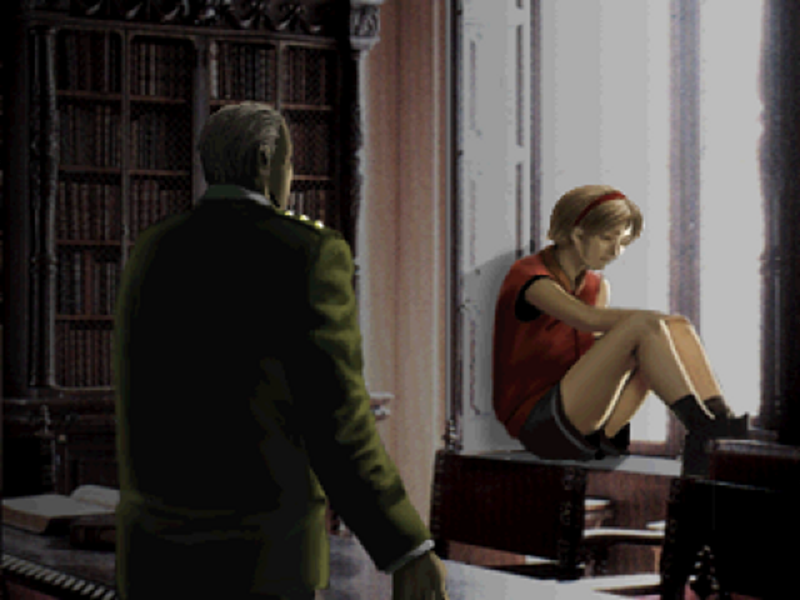
Resident Evil 3 lead writer Yasuhisa Kawamura explains this new organisation:
“This is an undisclosed organization whose primary mission is to gather information about bio-weapons and to produce effective countermeasures. There is a very real threat of deadly bio-weapons going out of control, clearly evident not only from incidents involving Umbrella, but with other groups such as H.C.F. & Tricell. The Raccoon City incident played a large role in the creation of this unit & Leon's extensive involvement lead to his recruitment. It's important to note this was also meant as a means for the U.S. government to keep a close eye on Leon & Sherry, who have learned too much about the existence of B.O.W.s. Sherry's position is more than a hostage that ensures Leon's co-operation, she’s of great significance, not only to the U.S. but to the world, but that's all that I can reveal…”
“The G-Virus was recovered by Hunk, Birkin was assassinated. As a result, Umbrella's entire objective was achieved. But there was accomplishment even in the U.S. such as the opportunity to establish a bio-weapon countermeasure force. Although soldiers trained until now were strong too, they weren't able to achieve results.”
— Yasuhisa Kawamura
“Therefore the U.S. military planned a swift review of a military unit. This military organization hired Leon, and he'd be murdered if he didn't go along with it. He followed the U.S. government in order to ensure Sherry's safety. With that, the United States succeeded in training a strong specialist. It's like the movie G.I. Joe!”
— Yasuhisa Kawamura
Our time-line of canon events that shed light on the origins of biohazard 3.5, brings us to Resident Evil: Code: Veronica, another game Capcom outsourced to Tose. Of specific interest is the scene that sees Claire use a computer with internet access, to contact Leon via email. (Japanese subtitle translation: “I'll get in touch with Leon right away. I want him to tell Chris he's being watched.”)
Moreover, Director Hiroki Katoh explains Leon's movements at this time, in the ‘BIOHAZARD CODE: Veronica Kaitai Shinsho’:
Q6: What was Leon doing when Claire sent the e-mail?
A6: Leon joined an underground anti-Umbrella organization. Since he was carrying out a certain duty while this tale was advancing, he wasn't able to come and rescue Claire (this scenario has been completed, but cannot be announced). For the moment, three people, Jill, Barry and Leon have joined underground organizations. However it's unknown whether Barry and Leon's organization is the same as Jill's organization. (Development Staff Q&A (page 287). Translation by ProjectUmbrella)
Almost certainly Katoh-san is referring here to the scenario of Resident Evil Gaiden, since Devil May Cry was in development, and there are no other titles involving Leon at this time with a completed scenario.
Hiroki Katoh also wrote Wesker's Report, which contains a reference to Leon's, and Claire's Resident Evil 3 epilogues:
その後クレアは兄クリスを探すために単身ヨーロッパに渡り、レオンは反アンブレラを掲げる地下組織に入った。
“Afterwards, Claire went to Europe alone to look for her older brother Chris, and Leon joined a secret Anti-Umbrella organization.”
Katoh-san is referring to the U.S. Government anti-B.O.W. unit that Leon joins. (He wrote the basis for Wesker's Report in a bar, after getting core members of the Biohazard team drunk, in order to loosen their tongues to glean valuable insight into the characters that he was so lacking in!)
Finally, a discussion centring on the origins at the heart of biohazard 3.5 cannot truly be complete without reference to a uniquely Japanese word - 'Mogaki'. This non-direct translatable Japanese word featured significantly during Yasuhisa Kawamura's interview with Crimson-Head.com
“Shibata, the director, had a very clear concept which he described as ‘seeking the horror’. He had the image of ‘the horror of mogaki’, or ‘struggling’. It can be difficult to directly translate this ‘mogaki’ word into its exact meaning, but it is a situation in which you try to wriggle with your whole body in fear, but cannot escape. He seemed to want me to create not just physical mogaki, but rather a state where Leon couldn't resist mental or psychological pains & difficulties. A kind of mogaki that’s simultaneously mental and physical.
This mogaki was used as the key concept within the production team frequently as the keyword created by Shibata. In fact, the word mogaki is sometimes displayed during the continuous pressing of buttons to escape from the enemies in actual biohazard 4 game. Unfortunately, it's not in the non-Japanese version, as the word doesn't translate directly into other languages.”
NOVEMBER 2, 2001: A new section appeared on the biohazard rebirth website, titled ‘Background Movie Test’. Director Shinji Mikami wrote: 開発前の研究段階での. 実験映像です。4つの動画背景を. 掲載しています。/ These are experimental videos from the planning stage before development. Four video backgrounds have been published.
“This is an experimental movie for the video backgrounds at the planning stage before development. These backgrounds are faithful to the world of biohazard, but that doesn't mean they were created with all stages of this production in mind. Therefore, it also contains backgrounds of scenarios which may not exist in this game's final production.”
動画背景の実験映像です。/ これらの背景は / 「バイオ」の世界観には忠実ですが、/ 今作の舞台を想定して作った訳ではありません。/ したがって、今作のゲーム上では、/ 存在しないシチュエーションの背景も含まれています。/
Background Movie Test (1). Chapel: This is a room engulfed in hell fire.
—実験動画背景画像 (1). 礼拝堂. 業火に包まれた部屋です。
Background Movie Test (2). Room with a bird cage. Lightning flashes through a window.
— 実験動画背景画像 (2). 鳥カゴのある部屋. から雷光が差し込みます。
Background Movie Test (3). Spiral staircase. Dripping with water.
— 実験動画背景画像 (3). 螺旋階段. 水が滴っています。
Background Movie Test (4). Stairs which go up a cliff. There's a rainstorm blowing violently.
— 実験動画背景画像 (4). 崖を登る階段. 暴風雨が吹き荒れています。
All but one of the above test backgrounds were taken further into the development of the next biohazard 4 build, the black sheep being the 'Room with a bird cage' (Background Movie Test 2). In the paragraphs below, observations will be made regarding the consequent involvement of those animated test backgrounds, that found their way in varying degrees, into Yasuhisa Kawamura’s beta build - the ‘Castle’ version. A comparison of the pre-rendered cliff-side stairs background, and the full polygon biohazard 3.5 Spencer castle, extracted by Welsh from the Biohazard: The Umbrella Chronicles Wii disc can be seen in the first two images below.
Having extracted the original biohazard 3.5 Spencer Castle, Welsh made the observation that it also appears, forming part of a pre-rendered background in Resident Evil remake, as a mansion painting (image above). The biohazard 3.5 castle paintings inevitably reappear because both games were developed concurrently; Production Studio 4 designers were part of Resident Evil and biohazard 3.5 development teams simultaneously, including the painting as a link to Spencer’s back-story. When studying the image you can see some characteristics of other biohazard 3.5 castle media related images in it, including a close similarity with the exterior of the Salazar Castle, in the retail version of biohazard 4 (image left). Other examples include Noboru Sugimura's castle from the previous DMC evolved version, by concept artist Makoto Tsuchibayashi (image 5 above) and Spencer's Castle painting as it appears in Lost in Nightmares (image 6 above).
In conclusion, these experimental backgrounds were most likely for testing the GameCube's technical capabilities in purposeful preparation for the development of biohazard 4, constructed using the biohazard rebirth assets. It follows from this that the Chapel, for example, differs in some details in comparison to the Chapel showcased at the 2002 Tokyo Game Show Castle trailer - there being almost a year's worth of additional development leading up to this public showing. Furthermore, producer Hiroyuki Kobayashi has since confirmed in past interview, that development of biohazard 4 truly began at the end of 2001, and curiously, the background movie tests were published during that same period.
JULY 15, 2002: “I don't think I can say anything about biohazard 4 yet, the young staff are struggling to make it good, so it’s changing everyday. Of course I’m checking what is going on, but we really don't know what’s going to happen. The only thing I say is biohazard 4 will definitely release only on GameCube, not on another console, if it happens, I’ll commit seppuku.” Shinji Mikami (Hyper Capcom Special)
CASTLE/FOG
Written by Yasuhisa Kawamura & Directed by Hiroshi Shibata, the beta ‘Castle’ version was premiered at the Tokyo Game Show 2002
SEPTEMBER 2002: The second biohazard 3.5 build, although commonly referred to as the 'Fog' version, (producer Hiroyuki Kobayashi has referred to it as both the ‘Progenitor’ & ‘Fog’ versions in interview with Rely on Horror) can be accurately entitled ‘Castle’ version, as this is the moniker used by its creator/planner Yasuhisa Kawamura. Kawamura-san created the ideas & stages, writing the scenario with Noboru Sugimura. Development insight can now for the first time be revealed, from Yasuhisa Kawamura’s interview with Crimson-Head.com
Whilst the released footage is short, it does consist of much significant, iconic detail, that consequently throw up many questions, to be explored in the paragraphs below; including the nature of the invading fog creature, the source & extent of Leon's contamination, whether Leon has been infected with the trailer referenced Progenitor, or other viral agent, is the existence of any virus an established contagion of the castle, or was it recently brought there, and if so by who, the significance of the airship, are inhabitants within the Castle, and if so for how long will Leon remain a lone explorer, and why was this scenario abandoned?
Past commentaries could only speculate upon answering those aforementioned lines of investigation because the build was unceremoniously canned (for reasons to be explained later in this section) before its narrative could be further explored publicly, but from the personal developer information now generously afforded the community, by Kawamura-san, considerable insight can now finally be revealed, below.
Detailed footage analysis of ‘Castle’ trailer
The spiral staircase from movie test (3), first seen at the biohazard rebirth site, at the end of 2001, now appears in real-time. The top and bottom of the staircase are blocked by debris (image below). Discussed in the analysis below, Leon S. Kennedy will also make an appearance in this location, pursued by the invading fog, that is to feature as the B.O.W. of this beta scenario, created by Yasuhisa Kawamura
The chapel from movie test (1) also makes an appearance in real-time (image below). During the development of this build it may have been decided that the entire Chapel area would burn at a particular game-play stage, or just as likely this was the development team's early experimentation with the GameCube's technical capability to perform sophisticated environmental effects, such as wind, water, and fire.


The Cradle of the Progenitor Virus /
始祖ウィルス発祥の地
The Japanese word 発祥の地 means ‘place of birth’ or ‘origin’ depending on context. biohazard 3.5 was supposed to answer questions that many had expected answered in Resident Evil Zero, namely what exactly is the Progenitor virus? What is its origin? And who precisely is Oswell E. Spencer? Despite the later narrative line of Kijuju and the ‘stairway to the sun’ flower - the Sonnentreppe, this Castle version scenario had nothing to do with the African setting of Resident Evil 5.
That this build did not concern itself with an African location is surprising considering the Resident Evil Zero file 'Marcus's Diary 1' which confidentially points to Africa. So irrespective of any foundations for the mother virus set down before it, the Castle version had a completely different setting in mind when revealing the origins of the Progenitor virus.
Ridley deconstructs the incestuous relationship between the teams & stages of titles in development simultaneously, to shed light on this African anomaly. When Kamiya's Resident Evil 3 build was canned, and his team consequently began work on their version of Resident Evil 4 (revamped into Devil May Cry), it was well into 1999. The initial scenario planning for Resident Evil Zero had already commenced in 1998, with the African setting already well established. With the DMC incarnation, Sugimura changed this location to the more precise Mallet Island.
April 2001, Sugimura confirms he was recalled to edit the scenario for Resident Evil Zero due to it’s console upgrade from Nintendo 64 to Nintendo GameCube. He consequently removed the African setting (at the same time as writing the script for the cinematics, which weren't a feature of the N64 version), which is the reason behind Africa's reference in one of the in-game file images whilst being omitted from the actual script. The motivation for this being that he envisioned an alternative setting for the cradle of the virus, being deep underground Spencer's Castle. It is likely he had a change of heart at the later date, since he has also stated that in Code: Veronica Progenitor did originate in Africa, with the script finalised before the setting for his biohazard 4 version had been completed. There is no absolute certainty as to why he made these changes, first Africa, then Mallet Island, then a return to Africa again, but it does strongly suggest that the development team were motivated to pay homage to Sugimura's work during their Resident Evil 5 project, and they adhered to Sugimura's notes regarding Africa, since this also neatly fits into the 'Black Hawk Down' theme they wished to portray.
N.B. It will be further discussed in the later paragraphs, that the ‘cradle’ theme ties directly in with another key word, consistently used by the developers when setting out their build's mission plan - 'core'; as highlighted by Director Shibata-san, and reported in Japanese video game magazine, Famitsu (see below), 'The core of Umbrella' is a key feature of Castle version's narrative.
Had this build progressed further, one would presume a considerable theme to have been the relationship between this series iconic virus, and it's creator Oswell E. Spencer. The actual degree to which this relationship was explored in the Castle version's scenario will be examined after a paragraph briefly detailing the appearances of both creator, and his viral creation, leading up to Yasuhisa Kawamura's new narrative.
After the removal of ‘Trevor's Notes’ from the original Resident Evil, having initially been game files written by Kenichi Iwao included on the promo trial disc 'Biohazard Taiken Ban', a 15 minute demo, Spencer then curiously does not appear in the series in-game, until Biohazard Gun Survivor:
ラクーンシティ崩壊後レポート
1998年8月5日. U.B.C.S.調査隊員からの報告書1: 5月11日に発生した生物兵器研究所、及びスペンサー卿の洋館におけるバイオハザードは、S.T.A.R.S.アルファチームのジル・バレンタイン、クリス・レッドフォードらが7月25日に施設を爆破する形で一応の終結を見た。
‘August 5, 1998. Report 1 from U.B.C.S. Surveillance Team Member: The biohazard that occurred in Lord Spencer's mansion and Bio Organic Weapons laboratory on May 11 tentatively concluded in the form of Chris Redfield, Jill Valentine and other members of S.T.A.R.S. Alpha Team blowing up the facility on July 25.’ ProjectUmbrella translation
The aforementioned correspondence between Spencer and his ill fated architect, George Trevor (extracted from the Biohazard Taiken Ban disc by Mark Grass & Welsh, and translated by Welsh & Biotech), which lead up to the insidious aristocrat's first use of the mother virus, clearly illustrate Spencer's spiteful dishonesty & murderous intent, in pursuit of his ego-maniacal goal. (‘Trevor’s Note’s’. ProjectUmbrella translation)
And whilst together with Sir Spencer, the Progenitor virus is equally chronicled in the Japanese biohazard guides, it too peculiarly does not appear in-game during the first few main title instalments, until biohazard rebirth, when it becomes the catalyst for Umbrella's sinister experimentation with human test subjects, and for Lisa Trevor's pitiful, yet revolutionary legacy:
‘Family Picture & Notes: Progenitor Virus variants administered (Nov. 10, 1967). Jessica TYPE-A administered. Tissue tore when cells were activated. Virus failed to establish itself. Disposed of. Lisa TYPE-B administered. Tissue tore when cells were activated. Virus establishment successful. Some positive results in remodelled vessel. Probation continued.’ (ProjectUmbrella translation)
The Progenitor virus would also make a staring role appearance in Resident Evil Zero, but whilst like Resident Evil, this would precede Resident Evil 4 in the canon narrative time-line, the retail release of this prequel would not be until after the development of the Castle build. However with Flagship at the helm of both, and Noboru Sugimura involved with the scenario of both (Castle version scenario writer & Resident Evil Zero scenario editor), there would be narrative consistency, with Resident Evil Zero due to explain Progenitor's relationship and to the t-virus, whilst Resident Evil 4 (in the guise of the Castle build) was to detail it's origins, in other words, to reveal ‘the cradle of the Progenitor virus’; and if the place of its birth was to be featured, then presumably it's father would take centre stage.
It was suggested had the Castle build advanced to an approved beta, a considerable theme of its concluding stages would surely be the relationship between Progenitor, and it's creator. Had the very first incarnation of biohazard 3.5 continued in the series mould, then that most certainly would have been the case, but with the Spencer role now occupied in a Devil May Cry parallel universe, his relative role in the build that now took on the biohazard mantle, would diminish considerably, possibly to the point of non-appearance, despite the scenario taking place within his own Castle! Kawamura-san confirmed as much in interview with Welsh for Project Umbrella, remarking that his omission may have been due to that relative role in the DMC deviation. And as for the question of Progenitor, and its potential role in a scenario centring on the place of its birth, Kawamura-san sheds light on this, exclusively in interview with Crimson-Head.com:
CH: What was the featured virus of your build, and was it brought into the Castle, or already present therein, and if brought in by an outside party, who was responsible?
YK: The fog - it is a new gaseous bio-weapon by HCF, which was a new bio-weapon company, that Wesker belonged to. It was brought into the Castle by a HCF squad, who planned to seize Umbrella HQ - Spencer's castle. Incidentally, Wesker did not enter at this point.
So no staring role then for the mother virus? Kawamura-san does however exclusively reveal to us that it was a feature of his scenario, but specifically in terms of background narrative, of historical relevance to the game-play, rather than of direct significance to it:
“According to the setting I created, the primal virus was a superhuman virus, found in an ancient fossilised human, at an archaeological site, deep underground Spencer's castle. This virus could not be applied to modern humans, but then the t-virus was created during a process of adaptation. However, while the t-virus could cause mutation, mutated beings could not thrive as a species (they were sterile), so there was no effective means other than to grow biological weapon through cloning. There is also a t-virus like t-Veronica, improved for the purpose of making oneself super-human. So, in order to transcend the t-virus, Dr. William Birkin developed the G-virus... Everything started from the castle owned by Spencer, when the ruin was found and aristocrats started digging. They found the primal virus and Spencer began to have his ambitions.” Yasuhisa Kawamura Crimson-Head interview
Leon S. Kennedy / レオン・S・ケネディ
The one remaining constant throughout all development beta scenarios leading up to and including the retail version of Resident Evil 4, is our protagonist, Leon S. Kennedy, returning from Resident Evil 2. The superior processing power of Nintendo's GameCube over a PlayStation 1, which had catered for Leon's previous design incarnation, would provide Kawamura and the development team with greater scope for their imaginations, and the ability to improve upon Leon's depth of character design.
The considerble upgrade on Leon's Resident Evil 2 character model is to its 3D presentation. When the Resident Evil sequel was released in early 1998, consoles championing 2D sprites had just made way for the PlayStation generation providing Leon's debut design. This early foray into 3D character models was in its infancy, and of limited polygon count. Kawamura-san in his introduction to the Castle version (see below) enthused that Leon and his environments would be full polygon, yet with the high detail of past pre-rendered backgrounds, showcased in the spectacular GameCube remake of Resident Evil.
Footage shown in the 'Making of biohazard 4' documentary (included on the ‘biohazard 4 Secret DVD’), presents Leon's considerably improved three-dimensional ‘Castle model’, animated in Maya 3D animation software. In conversations during the production of Welsh's ProjectUmbrella interview with Kawamura, it was confirmed that Leon's biohazard 4 hairstyle was inspired by John Connor's film Terminator 2: Judgement Day and his jacket was indeed fashioned with inspiration from the film ‘The Mummy’!
Leon's beta model does not enjoy the good health afforded to the retail version that heads to Spain; he is clearly suffering great pain, seen in trailer shots of Leon convulsing and holding his arm in great discomfort. How he became to suffer such injury, or more likely an infection, is explained during Yasuhisa Kawamura's interview with Crimson-Head, in the proceeding paragraphs:
Invading / 浸食
The Japanese word 浸食 (Shinshoku) means an ‘erosion’, or ‘corrosion’. This is clearly referring to the erosion of Leon's physical, and mental state, as the game progresses further, and his deterioration gathers pace, from the injury/infection he is shown to be afflicted by. This tension inducing game-play mechanic, the continuing erosion of the player's health, was continued into biohazard 4 retail version, employed by the ingestion of a plaga, and the consequent deathly countdown to its birth…
The specific nature of what invades Castle build Leon is unknown, but his continuing deterioration is symbolised by the invading foe, relentlessly stalking our protagonist. Four occasions in the space of relatively short game-time footage (56 secs), it takes centre stage, suggesting it may have provided the relentless pursuit and signature B.O.W. antagonist that Nemesis brought to Resident Evil 3. The physical biology of this invading fog enemy suggests it to be a design ancestor of a more recent viral embodiment, Uroborus. Yasuhisa Kawamura has confirmed that all was not as it seems, and the invading tentacles, may have been a precursor to the blurred lucidity of those that also pursued Leon, in the later developed Hallucination experiment. “The tentacles might be a hallucination and they might not be.” Yasuhisa Kawamura Crimson-Head interview
Whether the Castle version's mass of writhing black tentacles stalking Leon represent hallucination induced symbolism of his mental erosion, or alternatively are an actual physical entity, its design bears strong resemblance to Uroborus from the six year subsequent Resident Evil 5, particularly in the earliest designs of Uroborus concept art (images below). As to the precise nature of this build's signature enemy, we know little, aside from Yasuhisa's exclusive insight, but what is clear is that the design was its downfall, and another financial nail in the Castle version's coffin. Over six years after this build was developed, the technology required to develop the game-play motion of the design comparable Uroborus, presented such great obstacle to the developers of 2009's Resident Evil 5, that with this hindsight, it's clear the invading fog was a design too far ahead of its time. Moreover, when asked if there were any elements specific to the new generation of consoles that could not have been achieved on earlier models, the Resident Evil 5 production director, and lead modeller were both unanimous in identifying one.
“I would say, the presentation of the creature Uroboros. The core element of this creature is the large amount of tentacles covering the body. Maybe we could have hit on this idea in earlier days, but it would have been abandoned at review phase because it was impossible to recreate. This depiction is not easy with any hardware, and it was quite challenging. Initially, we had to reduce the number of tentacles by about 50% for the final Uroboros but our highly-motivated staff wanted to develop a creature like never before and persevered to create the birth of Uroboros in RE5... The development team nicknamed Uroboros ‘wiggles’. The modelling was pure hell, and of all the enemies, it was the greatest challenge as far as art and skill were concerned.”: Resident Evil 5 lead modeller Makoto Fukui.
“The technology we used for Uroboros is so new that we're working on getting a patent for it.”: Resident Evil 5 production director Yasuhiro Anpo.
Given this insight into the process that created Uroboros, over six years after Kawamura struggled with his closely comparable representation of the ‘Castle virus’, it's not surprising when he bemoans “There were many obstacles to overcome and the cost of development was deemed too expensive.” (Project Umbrella interview)
According to Yasuhisa Kawamura, any resemblance we have observed between his ‘fog’ B.O.W. and the subsequent Uroborus in Resident Evil 5, may just be coincidental, and he confirmed this, in interview with Crimson-Head.com “The tentacles might be a hallucination… The Uroborus virus was not part of this and was created for Biohazard 5.
These two viral agents certainly seem to have a very similar biology, a conclusion arguable from Yasuhisa Kawamura's further revelations to Crimson-Head, detailing the fog's genetics for the first time: “The ‘Black Fog’ is collection of viruses, gathered to form a bacteria sized entity, they behave as if they have a unified, sole intelligence.”
Contamination / 汚染
The Japanese word 汚染 (Osen) means ‘contamination’, but is often translated as ‘infection’. Kawamura-san explains exclusively to Crimson-Head how this contamination befell Leon, so early on in the gameplay:
“They ran into and battled with Leon's army, HCF troops were destroyed by the Black fog. Leon's army were also destroyed except for him, but Leon himself was also affected by the virus with just a little time left to live and then having to fight in what little time he had remaining.”
Whilst it has now been exclusively revealed Leon was infected with HCF's new gaseous bio-weapon, brought into Spencer's castle, by Wesker, little is known about the mutation genetics of this infection. I strongly argue that there would be a form of consistency linking the development of Leon's contamination, and the invading fog that pursues, with its mass of Uroboros-esque tentacles. Consequently, when identifying potential clues for determining the features & characteristics of each stage of mutation, one can look to the disfigurements associated with the virus HCF's bio-weapon may have provided inspiration for - Uroboros; specifically the physical symptoms displayed by both infections, in the same limb (Uroborus concept art below). Any reference the aforementioned concept when considering the features of Leon's infection, can only be speculation, so I would prefer to focus on that which can be factually determined for his contamination & symptoms. The point of focus for highlighting Leon's infection is his arm; he clearly displays discomfort towards it, and this reactions identify the arm as the source of his pain.
Nothing further to identify the biology, origin or symptoms of Leon's contamination is evidenced in the available footage from Castle version. But that's not to say that the subject of Leon's contamination and resulting mutation was not a developed narrative, complete with story arc, in this scenario. Looking over Resident Evil 4’s development, a year after retail release, series producer Hiroyuki Kobayashi draws on completeness of game narrative and the significance of Leon’s contamination in-game, during interview with video game magazine EGM (#190 April 2005)
EGM: You've said before that you went through three other versions of RE4 before you settled on this one. Can you tell us about those?
HK: Well, the first version was the story of Leon as he infiltrated the headquarters of the Umbrella corporation. The enemies were completely different from what you see now.
EGM: Zombies and that sort of thing?
HK: That, and other monsters very close to that style. The twist was that there was some sort of hidden power locked inside Leon's left hand, and you'd discover what it was as you played through the game.
From personal developer information revealed by Kawamura-san in interviews for ProjectUmbrella & Crimson-Head, with footage ripped by George Trevor of consequent Hallucination gameplay, coupled with past observations & extractions by Mark Grass, Ridley, and Welsh (‘Hallucination’ section below), and insight by Leon's then voice actor, Paul Mercier, considerably more is known regarding his contamination.
“The virus was allegedly to take Leon over… his arm was gonna turn into a 15 foot snake & it was going to be so painful!!”
Paul Mercier, voice actor to take up the mantle from the wonderful Paul Haddad provided further clues on the physiology of Leon's infection, and how its affects during gameplay. In Sep 2009, he gave interviews with unWIRED TV, and website REVIL, in which the subject of Leon's character, created for the Castle build, was discussed.
UWTV : How was your experience with Resident Evil 4?
PM : Agh... I can't hold on much longer so let me just tell you this right now. She (Kris Zimmerman) was the original one who cast the demo for Resident Evil 4. So I came in and worked with Gordon Hunt and we worked on all sorts of things because the virus was allegedly to take Leon over. And it was going to come out of his arm and his arm was gonna turn into a fifteen foot snake. And it was gonna be so painful; there was nothing to be lived through and it would eventually kill Leon! But they didn't like that too much so they like, threw it out, but they kept me. So I'm like, ‘Cool. When's the next gig?’
REVIL interviews Paul Mercier - Past, Present & Future (September 2009)
“When I received new pages from the localizer, Shinsaku Ohara, he related that they were very happy with what we were doing. So Leon really became a team effort. At that point in the character development, the virus had infected him. There wasn’t much of a story yet, so the focus became about what would happen to Leon if he started mutating. How would this affect his mind, his body, and how he could overcome what was taking him over. And if it did overtake him, then how would they create missions around that.”
Turning our attention back to the Castle version footage, nothing further can be elicited in determining the origin, biology, and symptoms of Leon's contamination. Not even the premier trailer for the Hallucination build would provide further revelation (‘Hallucination’ section below), and it would not be until the release of a biohazard 4 promotional DVD, and the inclusion thereon of game-play footage from Hallucination version, that the subject of Leon's infection would be visited again.
Possessed / 暴走
The Japanese word 暴走 (Bousou) translates as ‘out of control’, and can refer to the state of madness. This directly referenced the new virus plaguing our protagonist with insanity. This became a signature feature of Kawamura’s experimental game-play scenario ‘Hallucination’. In the section below the relationship between Leon's possession during the Castle build, and the source for his Hallucinations in that later game-play test will be explored with Kawamura-san as part of our accompanying exclusive interview.
NOVEMBER 14, 2002: Capcom's visionary developers from Studio 4, including biohazard 4 director Hiroshi Shibata, with Shinji Mikami at the helm, announced simultaneously, five debut headline titles, all exclusive to the GameCube, during a momentous Capcom press conference.
The Castle build incarnation of Resident Evil 4 was named among the rosta of showcased titles, which Mikami-san specifically highlighted for being of particular strength through originality, evidenced by this group of five exclusives containing only one sequel. Shinji Mikami went further to explain he had wanted to steer clear from the unoriginal, ennui provoked by a video games market, that over the previous few years had become over saturated with sequels. Japanese video game site GAMEWatch reported on the now iconic press conference:
GAMEWatch report by Minoru Funatsu:
発 表会の冒頭、壇上に立った第四開発部部長の三上真司氏は「ここ数年、続編などが多くゲームが面白くないと感じていた。今回発表するタイトルは 『biohazard4』以外はすべてオリジナルです。普通に考えれば今の時代、オリジナルで勝負するのはバカげていると思われるかもしれない。でも、 我々のやってきたことはもともとベンチャービジネスで、純粋にクリエイタの作りたいものを作り、それをみんなに楽しんでもらいたいと思っている。そういっ た意味合いもあって今回の発表会を企画した」と挨拶。
At the beginning of the presentation Studio 4’s Shinji Mikami, stood front of stage and began the presentation:
“I feel that video games have started to become boring in recent years, as many releases have been sequels. The titles we will announce are all original, except Biohazard 4. Convention may consider it a mistake to include (Resident Evil 4) among only originals. But we have focused on only creativity and I hope that everyone enjoys it. Our presentation had been planned with this mindset.”
こ の考え方は、「バイオハザード」シリーズをニンテンドーゲームキューブで発売していくと発表した時に語られた話と共通する。今回発表されたタイトルを見る と、いずれも制作者の想いがダイレクトに反映されているため、あくの強い作品が揃っている。それだけにユーザーを選ぶゲームになりそうな気もするが、いず れもワクワクするような魅力的な作品だ。こういった想いは今だからこそ大切だと思うのだが、なかなか貫くのは難しいところ。カプコンにはぜひともがんばっ て個性的で面白いゲームらしいゲームの制作を続けてもらいたいと思う。
“This approach is similar to the one that greeted the arrival of the biohazard series to Nintendo GameCube. Looking a our current line-up of games, they reflect directly the creator’s vision. They might therefore divide players, but they are all very uniquely interesting games. We really hope that Capcom keeps striving to produce unique and interesting games that are true to gaming.”
一 番最初に紹介されたのが「biohazard4」。1分程度だが、ついに映像が公開された。「始祖ウィルス発祥の地」、「侵食」、「汚染」など気になる言 葉がちりばめられた映像はニンテンドーゲームキューブ版「biohazard」と比べてもなんの遜色もない圧倒的迫力だ。主役はレオン・S・ケネディ
The first game announced was Biohazard 4. The trailer, around one minute long, was finally open to the public. Interspersed with intriguing words like ‘the birth place of the ancestor virus’, ‘erosion’, and ‘pollution’, the trailer is extraordinary powerful and looks stunning on Nintendo GameCube. The protagonist will be Leon S. Kennedy.
だが、そのエンジンはフルモデルチェンジされており、フルポリゴンで描かれている。このフルポリゴンの映像がプリレンダームービーに匹敵する美しさで表現できるところまできたのだという。
つ いにフルポリゴンで描かれるということだが、カメラはこれまでのように固定なのかどうかが気になるところ。この点についてディレクタの柴田 洋氏は「『バイオハザード コード:ベロニカ』程度のことは当然として、現状では好きなときにプレーヤーの視点でゲームを進めることができるようにしていくつもりでいる」とコメント してくれた。
も ちろんこれは制作途上のことで、仕様変更になることもあるだろう。ただ、これまでにない「biohazard」を見せてくれそう な期待に溢れるコメントだ。制作者側としては固定カメラだけではなく、一人称視点での恐怖も同時に考慮しながらステージの構成や演出を考えなければなら ず、制作がかなり難しくなるはずだ。もちろん決定事項ではないが、楽しみなところだ。
The game-engine has been rebuilt to work with full polygon graphics. They say that this full polygon design has reached the level comparable to the beauty of pre-rendered backgrounds. We are very curious about whether the camera viewpoint is going to be fixed. The director Shinji Mikami commented on this:
“At present we are going to produce it in a way that players can play from their own viewpoint any time they want to, at least as much as they could in Biohazard Code: Veronica”.
Of course the game is in development and there may be changes to the design. But that comment is promising as it suggests a Biohazard we have never seen before. It should be quite difficult for the developers to design scenarios and effects inducing horror from both a fixed viewpoint and a changing viewpoint. Again this is not a finalised decision, but we very much look forward to it.
柴 田氏は「biohazard4」について「これまでのシリーズに比べてとてつもない極限状態に追い込まれる。そこで、かっこいい男が死ぬほどもがくのがポ イント」と説明。この“恐怖”をコントローラを通してユーザーに体験して欲しいのだという。最後に「しがらみを捨てて新しいホラーゲームを作る」と意気込 みを語った。発売は“200X”ということで、まだまだ先のことであり制作もこれからだが、やはり強力に楽しみな一作だ。
Hiroshi Shibata spoke about Biohazard 4: “… a story of a man in deep struggle; this struggle has always been the main theme of the series, but in this game I want players to feel like they're struggling to survive the most brutal situation of their lives”. He wants users to experience this ‘fear’ through the controller, and expressed his enthusiasm to create a new horror game without limits. We have to wait until its release in 200X. “It is still a long way off. Development is yet to begin. But our expectations are definitely high.”
エンジンを一新し、フルポリゴンで描かれるという新しいホラー「biohazard4」。公開された映像はまるでムービーのようだったが、すべてゲーム中の画像だという。とにかく圧倒的なグラフィックのクオリティだ
Biohazard 4 is a new horror experience, with its game-engine completely rebuilt to produce full polygon models. The trailer unveiled was of movie quality but it was all in-game footage. This is an extraordinary level of graphics!
Excitement began to generate throughout the industry's press, enthusing on the originality of the four new titles Shinji Mikami had debuted, with particular focus not surprisingly directed towards the next generation design for the next Resident Evil game. After the presentation, Capcom's official biohazard 4 Japan website went on-line, publishing further details from Director Hiroshi Shibata, who drew special attention to the game's mature presentation, its tense atmosphere, and the superior graphics.
“The next biohazard release on GameCube takes place at the centre of Umbrella, the birthplace of the Progenitor virus. The protagonist is Leon S. Kennedy from biohazard 2. The theme is fighting to survive in harsh conditions. Leon features once again in biohazard 4. As the protagonist faces harsh conditions, I want players to experience his struggle. Footage uses full polygon, the graphics will compare to full renders in past games. Please look forward to a unique horror game.” (Translation by Welsh)
As 2003 approached, further details from those already revealed to the press at the end of 2002, were thin on the ground, but this didn't waiver the resolve of the press to speculate on this potentially revolutionary instalment into an already legendary series. The first press feature to carry detailed coverage, was by Japanese video game magazine Famitsu, presented below with Crimson-Head.com translation:

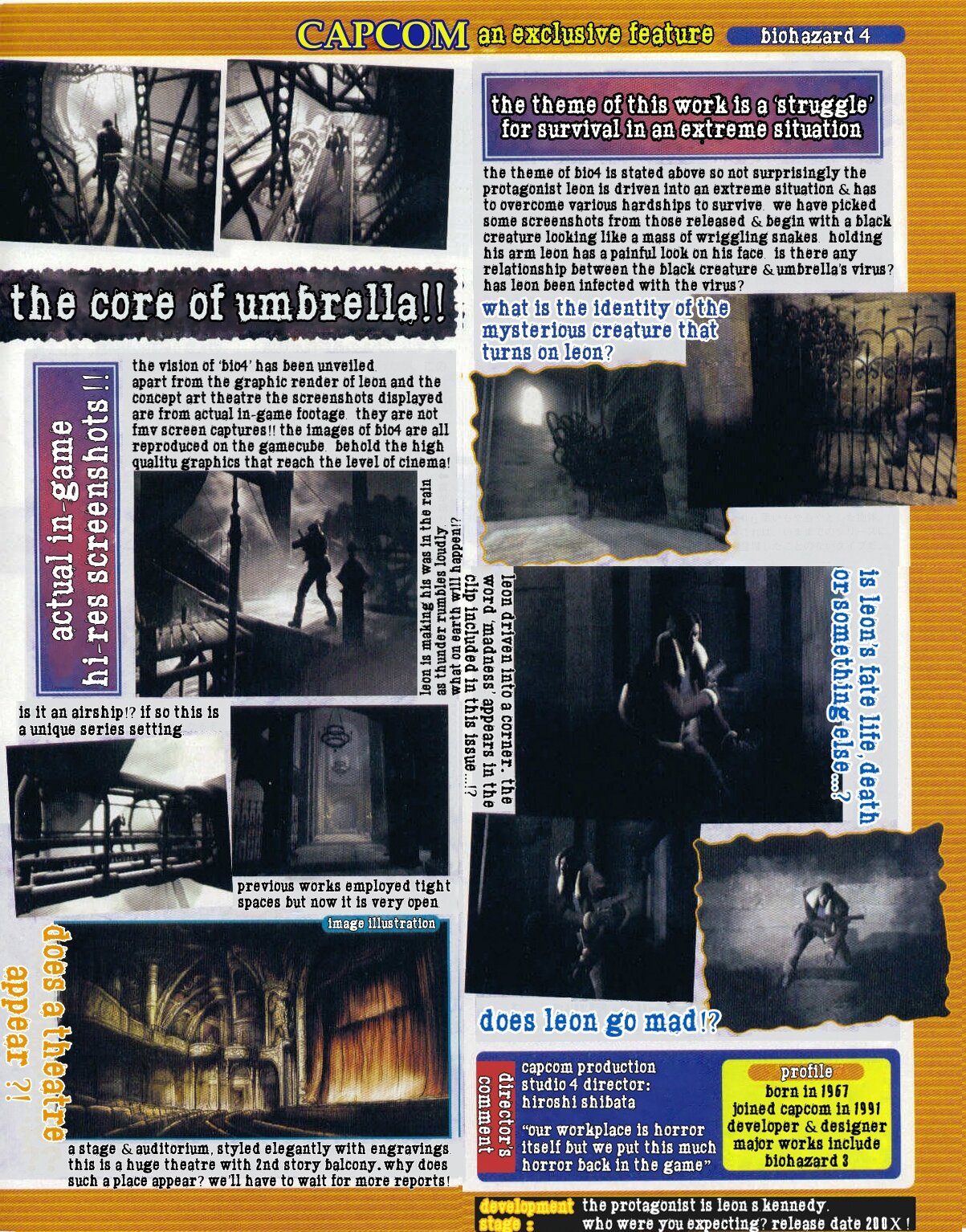
“This time in order to rejuvenate, we inserted new DNA. Regarding biohazzrd 4, we are challenging ourselves to make a new Biohazard.. We want users to anticipate the game instead of buying it just because it is the latest game in the series. Wasn’t Dragon Quest like that in the Famicom era? To do that, we injected new DNA by pulling directors and asking them to try to change Biohazard. We are in the process of a full model change. The goal is not to change the style, but to have a game that would make players raise their voices and exclaim ‘ohh!’ like in the original Biohazard.” Shinji Mikami interview with Famitsu (11/24/2002)
The one piece of concept art published in the Famitsu preview among a plethora of game screens was of an elegantly designed auditorium, its architecture distinct Romanesque style (Romanesque theatre image above), not out of place within the similarly designed Castle complex. Romanesque architecture is an architectural style originating from Medieval Europe, particularly characterized by frequently featured semi-circular arches, which are likewise in abundance, both in the design of the auditorium concept, and the Castle locations. The historic European context cutely matches Lord Oswell E. Spencer’s family history. During our interview with Yasuhisa Kawamura, we took the opportunity to ask him about this concept artwork.
CH: Here is a piece of concept art, from the Famitsu feature on the Castle version. As you can see it shows a large theatre stage and ornate auditorium. Were you involved with this design, I have further questions if so?
YK: I am not familiar with this.
So unfortunately, beyond our translation of Famitsu’s converge, nothing further is known as to the significance of this mysterious auditorium.
JANUARY-APRIL 2003: With scant details, other than those gleaned from Capcom’s Studio 4 press conference at the end of 2002, the industry’s coverage had little to scour other than that debut trailer, and to pick apart Shinji Mikami’s November presentation.
Press coverage outside Japan was not as informative, providing sparse detail (Nintendo Power #164 Jan 2003 & Edge #119 Jan 2003), or features embellished with inaccurate detail (GamePRO, March 2003). The German GamePRO article whilst offering mostly accurate coverage (from Capcom's 2002 GameCube press conference) was flawed from the start, reliant as it was on an infamous fake interview.
These inaccurate revelations include the erroneous claim that the partner zapping game-play mechanic employed in Resident Evil Zero would be making a return, and that a second playable character, in the guise of an Umbrella employee, would act as the co-op partner. To highlight both the correct and the erroneous information, Crimson-Head.com presents our translation below:


Nintendo website NINTENDOJO gave further observations with Capcom Japan providing a little more meat to the bones of their GameCube showcase press conference, revealing more about the style of gameplay to be expected:
‘Having promised a game of ‘faster pace’, (Capcom) are in fact doing a massive restructure of the player interface, providing a traditional control scheme in the newly established, fully three-dimensional environment. Action is to reach a happy medium between the tactical gunplay of past RE games and the frenzied combat of Devil May Cry. This is not surprising, considering Shinji Mikami confirmed Devil May Cry to originally be Resident Evil 4, before he decided it wasn’t what he wanted out of the sequel and salvaged the project for a new PS2 franchise.’
Shibata-san was then quoted “The biohazard series has always been bound by something before, but the new full-model engine will free biohazard 4 of these bonds. I want to make a completely new horror game.”
Their press report went further, revealing a significant game-play mechanic, allowing the switch from a first person to third person perspective, but as we will learn from the man at the heart of Capcom’s biohazard 3.5 production, this proved to be more erroneous speculation.
‘Capcom has opted to do away with pre-rendered backgrounds, but promises to keep the same amazing textures & environments that have been seen throughout the series. You can even choose between third AND first person perspectives in what promises to be an immersive 3D environment. The story is set to be a climactic epic; a series culmination of sorts. That’s what the director, Hiroshi Shibata, has said at least.’
During our interview with Kawamura-san, he set the record straight, confirming such a significant mechanic was never an option for his scenarios. GameCube technical limitations would not have allowed, and such major choice gameplay style would not feature for another seven years, until 2010 DLC release for Resident Evil 5, ‘Lost in Nightmares’, where it was briefly available to the player for the opening section.
We have seen that the Castle scenario narrative was complete, but what of actual gameplay percentage completion? What of the scant material released, in the form of the 2002 TGS trailer, can be considered game content, rather than FMV?
エンジンを一新し、フルポリゴンで描かれるという新しいホラー「biohazard4」。公開された映像はまるでムービーのようだったが、すべてゲーム中の画像だという。とにかく圧倒的なグラフィックのクオリティだ
‘Biohazard 4 is a new horror experience, with its engine completely renewed & designed to use full polygon. The trailer unveiled was movie quality but it was all in-game footage. This is an extraordinary standard of graphics.’ GameWatch report
Various industry press reports put the completion percentage at between 40-50%. Online video game magazine GameFront.de reported ‘Neue Infos zu Biohazard 420.11.02 - Wie Capcom in der aktuellen Famitsu Cube & Advance mitteilt, ist noch nicht entschieden, auf wie vielen DVDs Biohazard 4 ausgeliefert wird.Der Entwicklungsstand liegt derzeit bei 40 %.’ / ‘As reported by Capcom in the latest issue of Famitsu Cube + Advance, it is yet to be decided how many discs biohazard 4 will require. The level of development stands at 40%.’
And another German report, featured in GamePRO magazine (March 2003), put completion percentage at 50% (above scan & translation).
As highlighted by Director Shibata-san, and reported in Famitu’s feature 'The core of Umbrella' is clearly a key feature. The Japanese word for 'very heart/core ' refers here to the location from where Umbrella is controlled, its headquarters; though, not quite in the literal sense. Yasuhisa Kawamura in his role as the scenario writer for Resident Evil 3 explains during his interview with ProjectUmbrella.net
PU: Do you remember if the Paris Laboratory from the opening of Resident Evil Code: Veronica was supposed to be Umbrella Headquarters?
“The location of Umbrella HQ is unknown. I was prevented from deciding when I was involved in development. But I think it could've been Mallet Island. The USA branch developed the Tyrant and Hunter, and increased its voice of influence within Umbrella's organization. Each of the head offices European branches sensed impending danger and rushed the development of powerful new bio-weapons.”
PU: Mallet Island was created for the biohazard 4 version of Devil May Cry. So, Umbrella HQ was originally intended to be Mallet Island, then the castle from Mr. Sugimura's version, then yours?
YK: My version was [the same as] Sugimura-sensei's version. I supported it. A branch office and laboratory near the head office developed the Hunter γ and Nemesis. After the incident of Biohazard 3, it's expected that each American branch rapidly lost power, including the Chicago branch.
We should take on board a less literal understanding of the singular connotations of the English translation of ‘Headquaters’, as we've seen it crops up again, during Kawamura's Crimson-Head.com interview.
“The fog is a new gaseous bio-weapon by HCF, which was a new biological weapon company, that Wesker belonged to. It was brought into the Castle by a HCF squad, who planned to seize Umbrella HQ - Spencer’s castle.”
One feature these two varying incarnations of the same concept do have in common, is their island location, whether it be DMC's Mallet island (image above), Spencer's castle setting for an Umbrella's HQ in Kawamura's ‘Hookman/Hallucination’ scenario, or the ‘Fog/Castle’ version inspired Spencer residence from Resident Evil 5 DLC ‘Lost in Nightmares’.
The (Fog) scenario sees Leon infiltrate Oswell E. Spencer’s castle estate, and with both castles in Demento/Haunting Ground and ‘biohazard 4 DMC’ version having island locations, it’s arguable this had a similar placing - hence, the airship. From the room list that covers ‘Castle'/Fog’ and ‘Hallucination/Hookman’ locations, (hacked) accessed from the Resident Evil 4 Trial Edition Debug menu (see room-list section below) we can glean further details for understanding the available gameplay, such as this unconventional mode of transport featuring too frequently to have been a mere FMV feature. And before we move on to the next stage in the development of biohazard 3.5 it’s important to note, the design of the ‘Castle’ scenario lives on in the aesthetic of Resident Evil 4’s Salazar Castle environment.
HALLUCINATION
Experimental gameplay scenario written by Yasuhisa Kawamura. Premiered at E3 2003.
MAY 2003: Yasuhisa Kawamura’s experimental gameplay - ‘Hallucination’, was premièred, during Nintendo's pre-E3 press conference, introduced to the awaiting auditorium with a welcome message from producer Shinji Mikami (see video above).
Amongst the packed audience of industry press, IGN staff enthused ‘Where the first offered static cameras and 2D backgrounds, this entirely original Resident Evil 4 title is now fully 3D... Character models are even more detailed than ever before, with breath-taking details such as hair and skin rendered deceptively well. The 3D environments show off awesome reflective surfaces... And while the game's camera is extremely dynamic and fixed like other RE titles, the trailer shows instances where the camera pulls in closely behind Leon and pans with him in every direction he aims. So players will not only get a better shot at their zombie victims, but they'll also get a brightly lit view of their ghastly surroundings.” IGN E3 2003 Resident Evil 4 First Look
Merely for curiosity value I have included a feature by video game magazine Cube (Issue #25 Oct 2003) focusing on Leon’s distorted consciousness, but aside from minor speculative detail, it’s merely a fan-fiction report. However another British publication NGC, chose to focus on game content, and less on fan-fiction, impressed by both the upgrade to 3D environments & character models, and the exceptional real-time lighting. Reporting on the swathe of software showcased at the Tokyo Game Show that year, NGC choose to headline their coverage with Resident Evil 4, (no new footage for TGS, with the E3 trailer taking centre stage) splashing coverage across their opening pages, ahead of all else on show (Issue #87 Dec 2003), and running an additional feature the following month (Issue #89 Jan 2004). Again, erroneously, the press would speculate on the possibility of a first-person perspective.
What little we can discover and can be revealed of the ‘Hallucination’ plot, is limited at best, due to the nature of this scenario. Written & designed by Yasuhisa Kawamura as experimental gameplay only, there would be no script. Due to technical obstacles, the scenario was not progressed beyond this test stage, and thus no narrative plot points could follow.
“Shinji Mikami, the producer, also stated Biohazard was a horror game, and often demanded a production that was revolutionary in the horror genre. The concept he used was that of ‘full model change’, right from the beginning of the biohazard 4 production. Mikami-san first wanted something similar to horror film ‘The Thing’, where you could not tell who was the enemy and who was a friend. I suggested a system where the game was about ‘fears and doubts’, but recapturing that essence in a game structure proved very difficult, and so it was passed on. With such trial and error I had some world views and concepts of game systems to test, and I thought they would be suitable to express the 'horror' that Shibata-san our director was searching for. The idea of hallucination, to be able to see into another plane of reality was one of them.”: Yasuhisa Kawamura Crimson-Head interview
The scenario written for the Castle build would have carried over, with Leon still infected by the same gaseous, fog B.O.W. created by Kawamura, although now its effects have progressed beyond a physical pain, and onto a mental deterioration, manifested in the form of hallucinations. The influences for this new theme, and how it would be represented in-game (discussed below), come from the horror & paranormal films enjoyed by Kawamura-san, and were reflected in the pseudo-paranormal enemies Leon encounters, that may have only existed in his mind.
“To express the horror… the idea of hallucination, to be able to see into another plane of reality.”
Commonly referred to as the ‘Hookman version’ (Resident Evil 4 producer Hiroyuki Kobayashi has referred to it as the ‘Hooked Man’ version in interview with Rely on Horror), a reference to the footage's signature enemy, that now replaced the invading fog as the main identified foe. Contradictory statements have referenced whether there be any link between these two antagonist roles, but with the available footage and confirmations by Kawamura-san in our exclusive interview, I will argue there was a strong link between ‘Castle' & ‘Hallucination’ scenarios, and as a consequence the gaseous fog B.O.W. and Mr. Hookman!
The more accurate moniker, as named by its creator & planner Yasuhisa Kawamura, is the ‘Hallucination’ version. Furthermore, when footage of the Hallucination gameplay was included on Capcom’s promotional DVD, ‘biohazard 4 Secret DVD’, it was entitled ‘幻の「バイオハザード4’ which directly translates as ‘Hallucination biohazard 4’.
Kobayashi-san had confirmed to Nintendo Power (Issue #182 p.44-48) that there was little or no connection between this next era in the biohazard 3.5 timeline and the preceding Castle version.
“We originally showed a video about Resident Evil 4 to get everyone excited in November 2002. That was the initial unveiling to the press in Japan. Afterwards, we decided to totally scratch all of that work and start over. Then we had a new video at E3. And guess what? We scratched that as well. The third time we tried remaking it, we didn't show it to anybody. We had a promotional video, but we had to scratch that as well. So this new style is actually the fourth time we have tried recreating it because we just could not get it to the level that we wanted.”
I question it being that straightforward, this over-simplified view distorts the truth, evidenced in trailer footage and statements by writer Kawamura-san. Hiroyuki Kobayashi misrepresents a process more fluid, creating comparative links between the Castle scenario and Hallucination gameplay. During our interview with Kawamura-san I explored this relationship, asking what elements, if any, from Castle scenario were carried over into Hallucination, and whether the location explored by Leon in Hallucination was the same Castle seen in the prior build:
“Usually, in the development of cinematic games, a game system is integrated into a world view and stories which are already defined, but this was not the case for biohazard 4. Our priority was to build a game system that induced fright and horror first. Therefore, both the Hallucination and the Castle were essentially trial and error ideas that we thought of implementing, which ultimately didn’t appear in the final version. The Castle scenario came first, it was the most established, then the Hallucination element came second. However, when the Hallucination was introduced into the narrative, the concept of the Castle, where Leon kept fighting while an illness was destroying him, was passed on. So although the Castle was replaced with the Hallucination, it remained in the game as an expression of Leon’s illness. Also the mechanic where Leon could view a hallucinatory or spirit world and fight against its residents when the fog filled in the room, was considered then too…
It was Spencer’s castle. Everything started from the castle owned by Spencer, when the ruin was found, and aristocrats started digging. They found the primal virus and Spencer began to have his ambitions. Leon infiltrates this castle seeking the truth, meanwhile deep in the catacombs of the castle, a young girl wakes up in a laboratory. She starts to ascend the castle, accompanied by a B.O.W. dog.” Yasuhisa Kawamura Crimson-Head interview
Series programmer & producer Kobayashi-san has highlighted the ambitious dynamic that distinguishes the design & gameplay mechanics of Hallucination, compared to the more traditional ‘Castle’ build it had now replaced, in interview with EGM:
“The next major version [was] the one where Leon was inside a building with the dolls and the hook enemy. The idea here was to create a very otherworldly sort of game, one that was filled with flashbacks and camera shaking, and odd colour effects. The sort where you never knew whether what you were seeing was real or just a hallucination. It took much more of a strong Resident Evil style approach to horror.”
In stark contrast to the narrative heavy Castle build, the footage that heralded Hallucination version's public arrival never made it beyond just that, isolated footage of experimental gameplay elements, to be inserted into a completed narrative, that so lamentable remains unwritten.
PU : I've heard that you also wrote the Hookman version of biohazard 4. Can you elaborate on the outline of the scenario and how complete it was before the game was cancelled ?
YK : Hookman was merely an experiment and there was no true back-story: Yasuhisa Kawamura ProjectUmbrella interview
Devoid of a complete narrative for such a rich & unique scenario, ‘Hallucination’ was merely test gameplay of design mechanics to frighten the player. Graphically superior to the retail build, Hallucination was victim of its own ambition, Kawamura-san and his team unable to overcome technical limitations of the GameCube. Moreover, retail Resident Evil 4 contains many Hallucination 2D object textures, in lower resolution than appears to be the case from trailer footage. So whilst another beloved beta Resident 1.5 is a case of scrapped product due to poor production values, biohazard 3.5 is more a case of scrapped product due to excessive cost and over-ambition. Kawamura-san explains in his Crimson-Head interview:
“In the winter of 2002, I gathered the staff and showed a scene from a horror film. It was a scene from ‘Lost Souls’, by Janusz Kaminski where the room started corroding blue and a killer started emerging, while the main character was washing her hands at the sink. This scene, this hallucinatory vision from the character, and the way the room changed in real-time moved me very much emotionally. So I brought up the idea of attempting this in a game. I wanted to make biohazard 4 scarier, and I suggested that the main character travelled into a hallucinatory world. This hallucination was caused by something caught in his vision, a ‘trigger of horror’. The first thing I wanted to create was the structure that the world would transform into, a horror hallucination world in real-time when viewing pictures, and other points of interest, or letters, etc. These would become triggers, as a means of seeing the story with clarity, understanding the truth behind the scenario, or seeing another truth outside the ‘real world’ scenario.”
“I wanted to make biohazard 4 scarier, and I suggested that the main character travelled into a hallucinatory world which was caused by something caught in his vision, a trigger of horror.”
“It was very interesting but was extremely difficult, as it meant effectively having two different worlds in one, operating simultaneously in real-time, which was a challenge given the memory restrictions and hardware specification in those days. In the process of resolving those problems, ideas from the other staff were adopted and the black fog, Leon’s monstrous arm, and the Hookman appeared in improvements and experiments. There were many experiments and proposals, such as peeling of enemy skins when attacking!”: Yasuhisa Kawamura Crimson-Head interview
The transient being outside Yasuhisa Kawamura’s ‘real world’, featured as a signature enemy is the ‘Hookman’, the most focused symbol of Leon's hallucination, but there are others, of more subtle design. Yasuhisa Kawamura's Lost Souls inspired blue-tinted contamination of Leon’s environment, triggers sinister apparitions to appear in the form of menacing visages (image below). Notice those dolls? We’ll be getting to those for their role as further manifestation of virus induced madness, and connections (along with other links) to survival horror classic, main inspiration for Resident Evil, Japanese film & Famicom game ‘Sweet Home’, in our detailed analysis of the Hallucination scenario.


Detailed analysis of ‘Hallucination’ trailer & gameplay
An immediate observation speaks to that link I propose exists between the Castle scenario and Hallucination gameplay (as evidenced by Kawamura-san to Crimson-Head, in contradiction to comments made by Kobayashi-san to Nintendo Power). The stone steps shown in background movie test #1 titled ‘Stairs which go up a cliff’, may lead directly to the building shown at the start of the trailer, joined by a stone bridge that appears in both screens! (see image below)
Also note the heavy rain drenching the bridge in the trailer footage, together with the description of weather surrounding the comparable bridge in the test screen, ‘There's a rainstorm blowing violently.’ This isn’t the only reappearance of the model, and it has been recycled in both retail Resident Evil 4 and the Hallucination influenced Resident Evil 5 DLC Lost in Nightmares (image below). But significantly, what building exists on the other side of those iron gates?
The Hallucination E3 trailer begins with footage of Leon walking away from a building resembling a castle, with further shots of him investigating an exterior with archways & stonework matching the castle scenario. The trailer transitions into footage of Leon entering the mansion location housing Hookman; making clear the locations and hence scenarios were linked and there existed intention within Kawamura’s team to combine the two as one narrative.
In the later section of this article covering the room list for both locations, Castle and Hallucination mansion, yet more evidence will surface, cementing this link as more than just trailer footage conjecture.



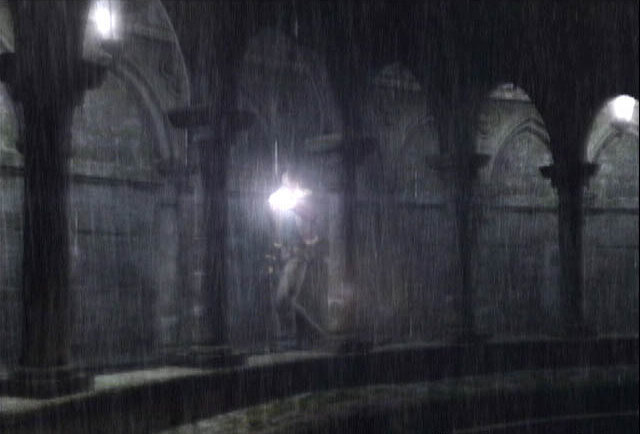
Surely such a link would dictate that Leon both exits the same building he inhabits in the ‘Castle’ version, and suffers a matching affliction, namely an infected arm. I’ve argued the first point as fact (images above) but footage of ‘Hallucination’ gameplay should display the effects of infection, whether physical, as with ‘Castle’, or mental as has already been established with ‘Hallucination’ (the clue is in the name!). But casting an eye on Leon's arm will do nothing to further the investigation into any continuing contamination carried over from the Castle build, as it is shows no sign of past infection. The further release of additional, extended gameplay footage did however develop the theme of the effects of infection on Leon, not just with matching footage of physical injury to his arm (see ‘Hallucination biohazard 4’ section below), but of course , the mental deterioration that his infection brings.
Screen captures of Leon's left arm (causing him anguish in the Castle) from both the beginning and ending of the E3 trailer, show no signs of infection, further underlined by Leon suffering no other physical sign of contamination symptoms. Despite Leon showing no physical signs of contamination, he is still evidently post-infection, due to the premier showcasing of his blue-tint hallucination perspective, as a representation of a mental corruption. This was the fist time the ‘Lost Souls’ concept by Yasuhisa Kawamura, was developed into a real-time gameplay mechanic, and as the haunting blue hue converts Leon's environment from foreboding location yet devoid of foe, to an intense attack mode, a chilling sound of chain on stone heralds the pursuing attack of a new signature enemy.



“A horror hallucination world in real-time…”
E3 trailer screen-captures show Leon's mental deterioration from the fog virus infiltrating Spencer’s Castle, clearly evidence by the manifestation of a blue-tinted alternate reality, but footage was yet to show any physical effects. Those would come in a gameplay walkthrough, titled 'Hallucination biohazard 4' / 幻の「バイオハザード4, on the biohazard 4 Secret DVD.
Released January 2005 for gamers who pre-ordered the Japanese GameCube release of biohazard 4, was a promotional DVD titled ‘biohazard 4 Secret DVD’. Amongst the standard fare of ‘The making of biohazard 4’, ‘Producer's interview’, and trailers, also surprisingly can be found walkthrough footage of Yasuhisa Kawamura’s ‘Hallucination’ test gameplay (video above).
Before we examine the biohazard 3.5 room list (ripped from Resident Evil 4 Trial Edition Debug menu), which will flesh out observations from both Castle & Hallucination scenarios, our translation below with extracted texture references, provides insightful commentary to gameplay footage:
YOU HAVE TAKEN THE 'FLASH GRENADE'
IT WON'T OPEN
THE DOOR IS LOCKED
The rug in this corridor is re-used in the retail version of Resident Evil 4. Distinctively placed either side of ornately carved doors are imposing shields crossed with swords, decorated with daggers (horse-head design). These are also found in both retail build and Devil May Cry. The ‘flash grenade’ would survive the scenario’s banishment to the cutting room floor, being an available item in the retail game.
After sixteen seconds this gameplay footage finally exposes evidence of physical mutation afflicting Leon, carrying over the feature of infection from the previous ‘Castle’ scenario, with the ‘fog’ B.O.W. designed by Kawamura-san prime suspect. Until now it was arguable the scenarios were connected by a common narrative, but now almost certain.
This image was revealed three years after the debut trailer for the Castle scenario, which showcased an infected Leon S. Kennedy, grabbing a clearly affected arm, and almost two years after the premier trailer for the ‘Hallucination’ gameplay sections, depicting our protagonist yet to suffer any physical affects from infection.
Close inspection of Leon's left arm, previously apparently healthy during the début trailer footage, reveals small, yet clear signs of infection, manifested as a mutation. This cross-scenario injury is cemented as a plot-point to tie the two scenarios together into one narrative, by a now iconic extraction by Mark Grass (Resident Evil 4 Trial Edition disc).
Leon's left arm has clearly undergone considerable mutation since we saw footage of his exploration of the ‘Hallucination mansion’ as showcased in the début trailer. Leather fastenings, possibly even metal clamps have suddenly appeared around the arm of Leon's jacket, the significant degree & force of physical abnormality has completely lacerated the jacket's tough leather, from bicep to wrist. These heavy-duty fastenings/clamps evidence not just the presence of infection, but the considerable force of the mutation’s abnormality. A dark discolouring to Leon's left had (image above), lesions across the skin, further evidence the mutation caused by a growing infection, gathering pace as a time-based gameplay mechanic - the extraction by Mark Grass (image above), a haunting warning of the consequences for our hero!
Whilst the development of the Hallucination scenario was more an isolated experiment of game-play, than a complete build, it still carried over the theme of Leon's infection; the infection ravaging through Leon's arm as seen in the Castle build, was consistently followed with Hallucination gameplay footage displaying an infected arm. I pursued this continued theme during my interview with Yasuhisa Kawamura for Crimson-Head:
“...the concept of the Castle, where Leon kept fighting while an illness was destroying him, was passed on. So although the Castle was replaced with the Hallucination, it remained in the game as an expression of Leon’s illness. Also the mechanic where Leon could view a hallucinatory or spirit world and fight against its residents when the fog filled in the room, was considered then too...”
TAKEN THE 'MOLOTOV COCKTAIL'
TAKEN THE 'ARMOUR ROOM KEY'
USED THE KEY
I discovered the painting texture (image above left), had been re-used in the biohazard 4 build developed into Haunting Ground, appearing in the retail version of Capcom’s other survival horror classic. ProjectUmbrella staff member Ridley identified this painting as as ‘Crucifixion of Saint Peter’ by Caravaggio, and the source painting for the other texture (image above centre) titled ‘Saint Francis’ by Francisco de Zurbaran, whilst fellow PU staff member Welsh identified the source texture for the doors, another asset carried over from Resident Evil remake.
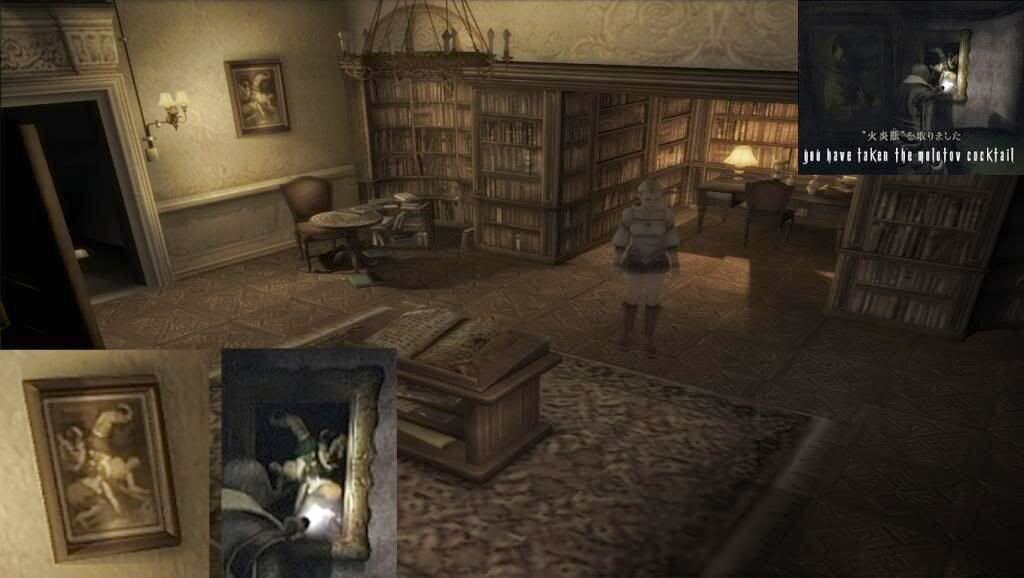
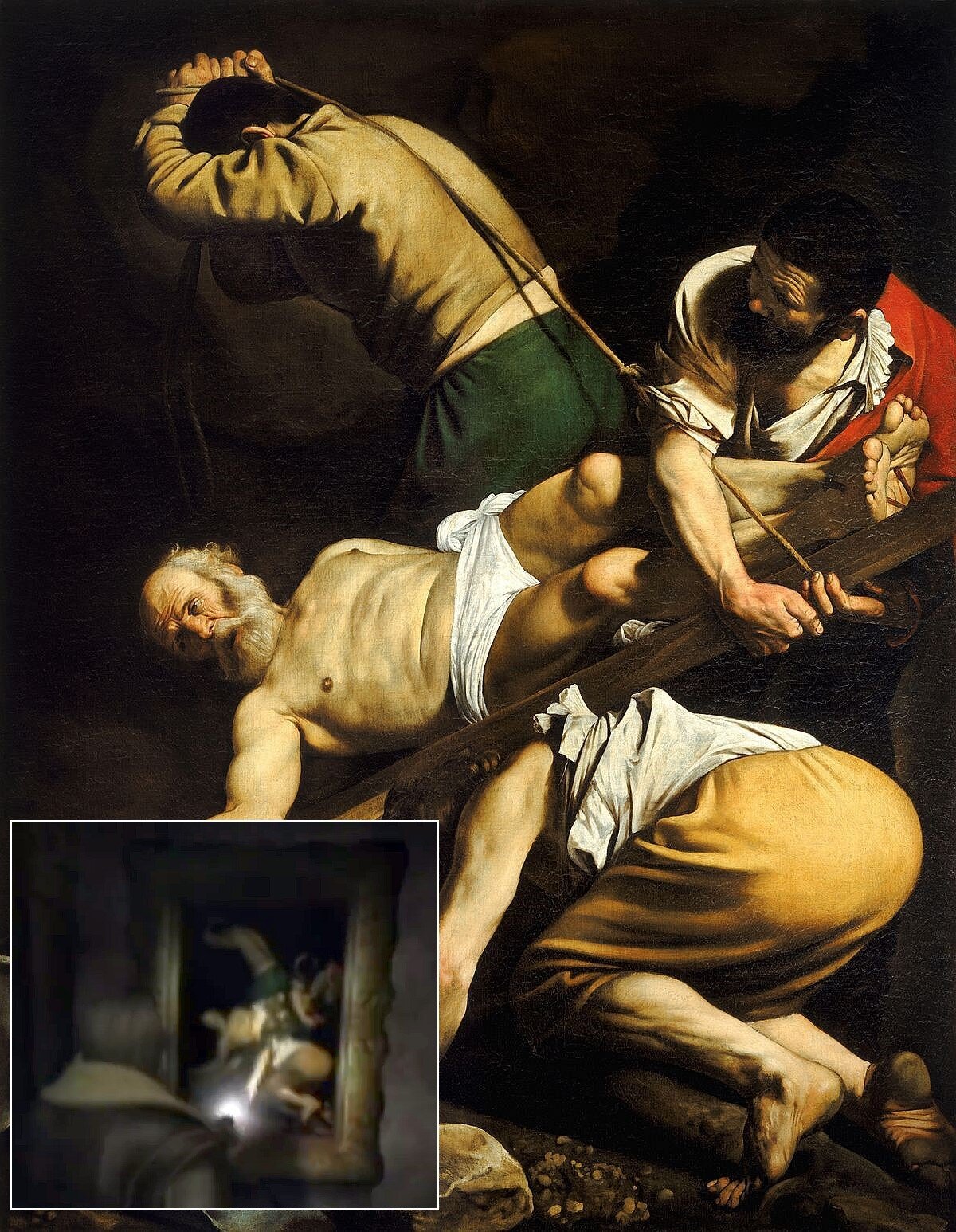


The next location is home to an equally iconic enemy to the beloved Hookman, and manifestation of Leon’s virus induced delirium , the dolls that pursue with sinister cackling. Not the first time in the series creepy doll figures have been utalised to induce fear & tension, as seen by concept art for the original Resident Evil (exclusively premiered by Crimson-Head). And it’s not the only element created by Kawamura-san for his ‘Hallucination’ scenario that drew influence from grandfather of survival horror, 1989 Japanese Famicom/NES video game & film ‘Sweet Home’.
Published in ‘The True Story Behind BIO HAZARD’, titled ‘Words from Producer on the Game BIO HAZARD’ (Crimson-Head translation), an interview with Shinji Mikami reveals that he planned on using Sweet Home as a starting reference during his development of Resident Evil. The two were based on the same game system and Resident Evil used many signature features from Sweet Home, that were to provide iconic ingredients for Shinji Mikami's own benchmark in survival horror. [Sweet Home as a major source of influence for the Resident Evil development & design teams, is covered in detail by the Japanese guidebook ‘Biohazard 2 Prologue Of Terrors’].
Like the Hookman, these dolls were merely present as a gameplay experiment, utalised to frighten the gamer, and consequently little is known about them in terms of their wider role in-game, and narrative placement. In the absence of further developer revelations, what we do know is only deduced from gameplay & interaction with Leon.
As with the Hookman enemy, the knights of armour, and the deer head trophy, the heralding of Leon's perspective change with the blue tinted gameplay, triggers their change from inanimate object, to real-time enemy; the same group of features from the blue-tint perspective that evidence Leon's hallucination symptom.
In both Sweet Home and ‘Hallucination’ the dolls are the only enemies to taunt the player with a laughter; the Hookman dolls, when animated in attack mode emit chilling high pitched cackle, in the spirit of the laugh accompanying the Sweet Home dolls’ evil welcome, delivered with a similarly creepy cackle “You will all die!! Hehe!!”
One mechanic designed for Yashisa Kawamura’s experimental gameplay that survived all the way to the retail build of Resident Evil 4, can also trace its roots back to survival horror classic; the animated knight armour enemies from both the Hallucination gameplay, and biohazard 4 retail, can be traced directly back to the ‘Armor’ enemy of Sweet Home.
A further link between Sweet Home’s roster of antagonists, and the pursuing enemies of ‘Hallucination’ gameplay, can be found in the ‘Mirror’ enemy from the Famicom game, and the Hookman we see haunting Leon’s delusional consciousness; specifically the nature by which these apparitions materialise as foes. Whilst the Hookman enemy originates from a portrait rather than a mirror, the stylised liquid-esque, reflective transformation from inanimate object to an enemy in-motion, emphasise the similarity between a trapped Hookman freeing himself from his portrait prison, and Sweet Home's trapped spirit attacking from beyond his reflective cell.
CHE: What, if anything, causes the mannequin dolls & the Hookman to animate, and then attack Leon? Are they merely non-moving hallucinations, or actually part of the lucid world? Are they B.O.Ws, or are they secondary infectants?
YK: They are mostly Leon's hallucinations. Some are hallucinations, but others could be B.O.Ws, or enemies in the 'real' world. However, they are far from lucid reality since Leon only sees them when he is delirious. So they die when Leon dies. You hear a story that a person develops a blister when he is hypnotised to believe that he's burnt. That was the kind of concept that we aimed to apply.
biohazard 4 Preview & Trial discs
In 2006, survival horror site The Horror Is Alive featured a detailed article chronicling the various biohazard 4 Preview & Trial edition discs. During this investigation by Dot50Cal & Mark Grass, remaining code once activated allowed the player to perform a time delay slow-down and other hidden abilities, including a crouch attack position, whilst the surrounding environment would shift into a light-blue distortion filter, reminiscent of Yasuhisa Kawamura's comparable gameplay mechanic, that would herald the symptoms of Leon’s contamination.
Data contained on these demo discs, including the room list for the beta scenarios, reveal that in the previous builds, Leon’s arm did suffer painful mutation, bestowing abnormal powers, as confirmed by Kobayashi-san in interview with EGM. Those abilities uncovered on the Resident Evil 4 Preview disc may have been the result of developer experimentation with the GameCube game engine, and were intended for biohazard 3.5 (see ‘room list’ section below). Extractions from the biohazard 4 Trial Edition disc provide further insight into the Hookman version, with an image detailing GameCube controls, and map showing all locations seen in the extended gameplay footage & trailer from the Hallucination scenario:


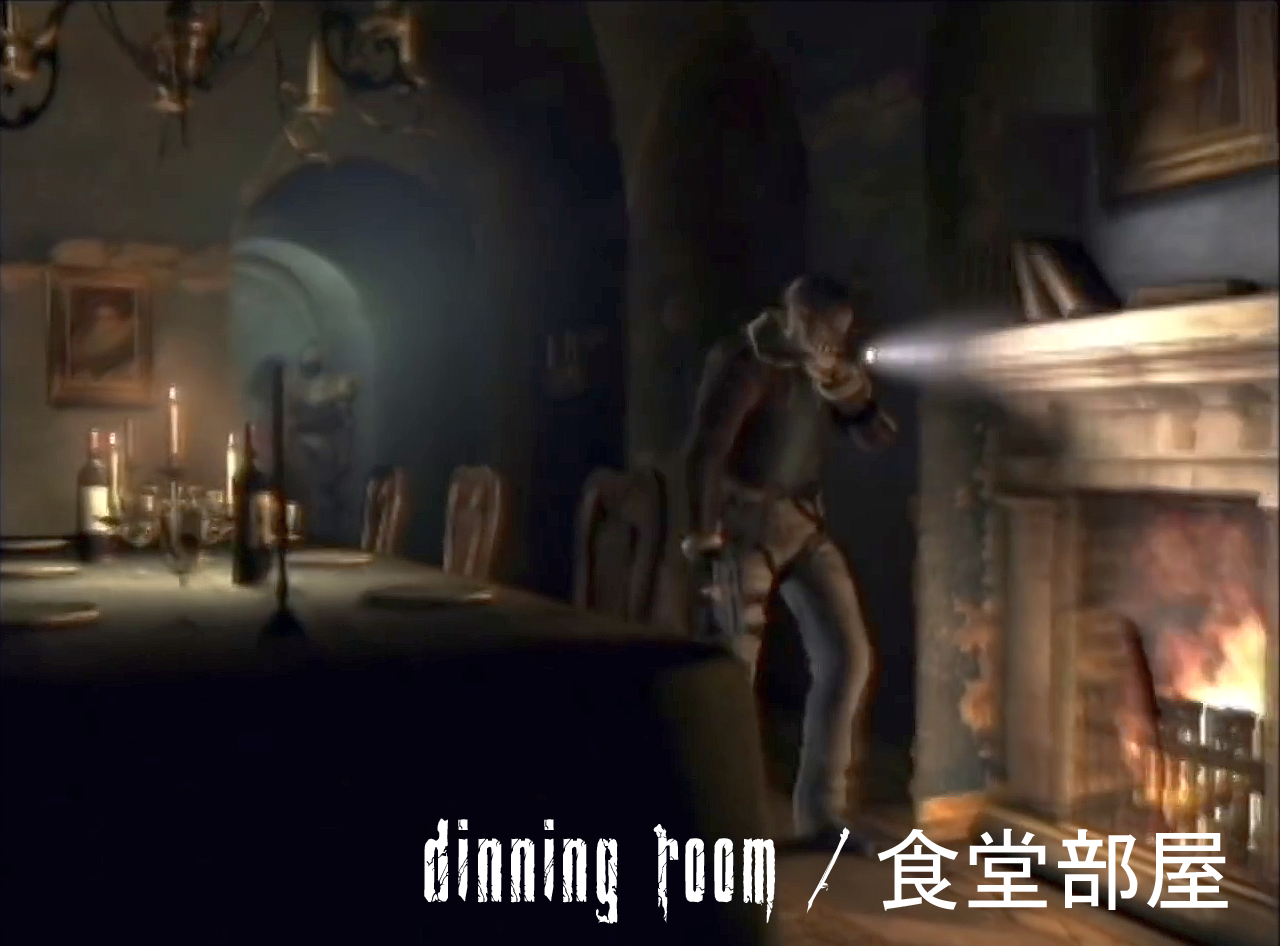
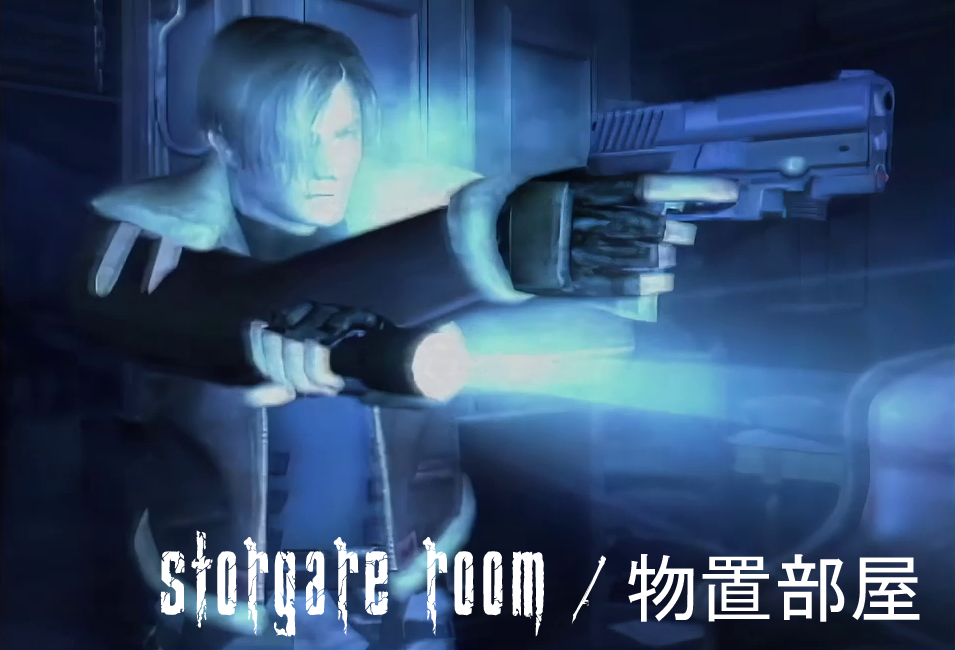


Room List:
The Resident Evil 4 Trial Edition Debug menu can be hacked to access a stage-list, organised into four sections covering the three main game locations (Village, Castle, Island) and a selectable area containing leftover data from biohazard 3.5. Below is the list of “Loadable Stages” covering the ‘Caste’ & ‘Hallucination’ scenarios/
00 - AIRSHIP
20 - airship_rouka / airship passage
41 - AIRSHIP_L_WING
42 - AIRSHIP_R_WING
With at least one large passage/corridor, and two separate wings (left & right) provided for the Airship stage, it clearly offered the opportunity for some gameplay exploration, but limited by its placement. Inserted at the beginning of the room list, it most suitably fits into the narrative at the start of Leon’s/gamer’s Resident Evil 4 story, due to his good health!
It would have served as a prelude stage, similar to Ecliptic Express section of Resident Evil Zero, ferrying players from the opening preparatory section introducing controls & features, to the larger more challenging main section. The influence of Leon's contamination on proceeding gameplay would develop with increasing degree, as the player progressed through each stage.
Leon could only enjoy a virus free existence at the start of the gamer’s journey, and from the opening scenes of the Castle trailer, it’s clear Leon's sanctuary from the invading fog and Wesker’s HCF wielding troops, was a brief pre-infection exploration of an airship gondola. This stage would be minimal due to the non-infection narrative, and limited space offered by such an unusual location.
01 - CURTAIN
02 - ATARI TEST ROOM
02 - HIT TEST ROOM: Most likely refers to various attacks which Leon can sustain. Used for animation testing.
03 - test
04 - DON BEYA
04 - OUTSIDE ROOM
05 - BLOCK TEST
06 - (unnamed)
07 - ARASHI / STORM: Yasuhisa Kawamura confirmed during our interview that Oswell E. Spencer’s castle is represented in both the Castle build and the Hallucination gameplay, which had the previous version’s stages carried over. This ‘STORM’ may very likely connect to the sheeting rain and violent lightening seen during the early stages of both the Castle & Hallucination premier trailers.
08 - MORI-test / FOREST-test (unknown relevance other than testing environments)
09 - SPIRAL STAIRCASE: Descending deep into the bowels of Spencer's castle, this is the early stage which first introduces the ‘Black Fog’ into the gameplay. We now know, with Yasuhisa Kawamura’s exclusive insight, that this stage sets the scene for Leon’s exposure to the new gaseous bio-weapon, brought into Spencer’s Castle, by the HCF squad, lead by Wesker.
(UNNAMED)
0b - CHAPEL: Carried over into the retail product, is the Chapel as a separate building location, housing the same chandelier (used by Leon to jump across to access the Salazar insignia light puzzle), and is also inspiration for similar interior design within Salazar’s Castle. This area was first seen all the way back in 2001, with the background movie test video #1, of a Chapel engulfed in fire.
0c - WATERWHEEL: The background silhouette of the airship clearly suggests that this is the docking bay, presumably leading to the entrance to Spencer's island protected castle.
0d - UNDER PASSAGE: Connecting main gameplay arena offered by the Castle, to a previous docking/landing area, Leon infiltrates Spencer’s castle from a clandestine underground passageway, with assets used for this area finding their way into the retail incarnation, Salazar’s castle.
0e - YOKOYAMA / MOUNTAIN SIDE
0e - YOKOHAMA / SIDE OF BEACH, PORT CITY
0f - NAKA NIWA (中庭) / COURT YARD: This may relate to an area that has always intrigued me, seen briefly during the Castle version sequence with the sprawling, huge windowed passageway, characterised by the wind blown, gothic curtains. The view from these iconic apertures overlooks a tantalisingly view-restricted courtyard. This location may also relate to a courtyard area (defined in Mark Grass's extracted map of locations revealed during the Hallucination walkthrough on ‘biohazard 4 ‘Seret DVD’), seen from the Bathroom window, offering a view of a mysterious humanoid figure (discussed below).
10 - DINING ROOM: Presumably the Spencer mansion-esque Dining room that features during the Hallucination game-play.
11 - WINE CELLAR
12 - TOILET
13 - FOOD CELLAR
14 - NOMO OKI / STORAGE ROOM
15 - EFFECT TEST
16 - (UNNAMED)
17 - DINING
18 - DOLL: Hallucination gameplay location, populated by the Sweet Home inspired, cackling dolls.
19 - BATH ROOM: Hallucination gameplay location, with an intriguing silhouette visible from the window, overlooking the courtyard. This figure is possibly the lucid-state version of the Hookman character, as he appears to have the same physical build and gait. Possibly relevant to an identification would be the mysterious third scenario that proceeded ‘Hallucination’ and Yasuhisa Kawamura's involvement, defined by the return to zombie enemies:
“The next was a version with ‘Zombie’ which we haven’t released to the public.” Rely on Horror interview with Hiroyuki Kobayashi
“It was a very traditional Resident Evil sort of game.” EGM interview with Hiroyuki Kobayashi
There is no evidence Yasuhisa Kawamura's scenarios included the series signature foe, notwithstanding this, there is no certainty as to the absolute non-appearance of other humanoid foes during Leon’s lucid perspective, as alluded to by Kawamura-san, in our exclusive interview:
“Ideas from the other staff were adopted… There were many experiments and proposals.”
1a - HAKUSEI ROUKA / TAXIDERMY CORRIDOR : Hallucination game-play location
1b - MONOOKI / STORAGE ROOM
1c - zikken / experiment
1d - TUTORIAL
1e - YAMANOUCHI / INSIDE MOUNTAIN
1f - ki / tree, wood
21 - Kensyuu / Training
22 - Kensyuu / Training
23 - MORI-DAY / FOREST-DAY
24 - MORI-NIGHT / FOREST-NIGHT
25 - castle_room
26 - Kensyuu / Training
27 - haikyo / ruins, abandoned building
28 - iseki / ancient ruins, historic ruins
29 - base_1
2a - base_2
2b - town
2c - Kensyuu2 / Training2
2d - Kensyuu2 / Training 2
2e - Kensyuu2 / Training 2
2f - OPENING ROOM
30 - HALL 3F
31 - MAIN HALL
32 - ARMOR PASSAGE : Hallucination game-play location
33 - ELEVATOR
34 - MINAMI GALLERY / SOUTH GALLERY
35 - KITA GALLERY / NORTH GALLERY
36 - GLASS PASSAGE
37 - JUNBISHITU / PREPARATION ROOM
38 - DOLL 1 : Hallucination game-play location
39 - THE PAST PASSAGE
3a - DOLL 2 : Hallucination game-play location
3b - KAIDAN MAE / FRONT OF STAIRS, BEFORE THE STAIRS
3c - KYUUTOUSITU / WATER SUPPLY, ROOM FOR BOILING WATER, OFFICE KITCHENETTE
3d - OUSETU & NIWA / RECEPTION ROOM, GUEST ROOM & GARDEN
3e - LV2 ROOM
3f - KITCHEN
40 - HITO_ZUKA / PORTRAITS, THE 'COMMEMORATION OF PEOPLE'
44 - SOUND TEST
biohazard 3.5 legacy
The Castle version was designed to be a GameCube exclusive title, produced to the same quality as the 2001 remake of Resident Evil. Moreover, the lead artist who designed the pre-rendered backgrounds also worked on the development of biohazard 3.5. There was a completed narrative with Resident Evil 2 returning protagonist Leon S. Kennedy, now an agent for a secret government organisation, travelling to Europe in search of the source of the t-virus - Progenitor. That is the ‘truth’ Kawamura-san refers to, during his Crimson-Head interview. Leon is infected wit the ‘fog virus’, encounters a mysterious girl deep in the castle, curiously together with a B.O.W. dog, and together they put an end to Umbrella by destroying its ‘core’, birthplace.
“… a superhuman virus in an ancient fossilised human, deep underground Spencer's castle… Leon infiltrates this castle seeking the truth, meanwhile a young girl wakes up in a laboratory. She starts to ascend the castle, accompanied by a B.O.W. dog.”
— YASUHISA KAWAMURA
No such rich story behind the ‘Hallucination’ scenario, being merely Yasuhisa Kawamura's experiment to render Hiroshi Shibata’s brief of ‘seeking the horror’ into Resident Evil gameplay. Graphically beautiful, atmospherically sophisticated it may have been, but it was devoid of narrative, aside from Leon’s infection inherited from the Castle scenario. Hallucination's environment was designed using stages of the Castle version (Spencer's castle), and many of its features found their way into the retail build, as object textures, albeit scaled down due to GameCube’s limitations.
Leon was always going to be a survivor of biohazard 3.5, as main cast with completed character, already agreed by Mikami-san and the Studio 4 team as the game’s protagonist, but of the mysterious girl he stumbles upon, deep within Spencer's castle, and her intriguing B.O.W. canine companion? Kobayashi-san in interview with EGM remembers with unfortunate less detail than Kawamura-san:
EGM: So no rescuing the president's daughter, or anything.
HK: Not at all, no, although there was a different woman around at that time, a girl who actually never got revealed to the public...
It has long been speculated these two biohazard 3.5 NPCs were re-located into another Capcom title, featuring as the main protagonists, in Demento/Haunting Ground. According to Kawamura-san in interview with ProjectUmbrella, biohazard 3.5 and Demento are not directly related despite their settings having similar features: “Demento is not related at all to biohazard 4... Demento was a different development department. We did not know what they would make.”
They were however both written by Noboru Sugimura, and do at the very least share some textures (including paintings as seen in image above), whilst unused concepts from biohazard 3.5 may well have been re-imagined into Haunting Ground’s narrative, including the female protagonist and her canine companion. So until our interview with Yasuhisa Kawamura, almost nothing was known about the narrative plot points to biohazard 3.5 and thus how its legacy affected Resident Evil 4. One element of retail Resident Evil 4 that can trace its routes back to the biohazard 3.5 era, is the Ganado. During our interview Kawamura-san revealed for the first time:
YK: We had the prototype of Ganados while I was still there. Originally it was applied from the idea of ‘doubts and fear’, horror of who was who, like The Thing. It was called ‘Doba man’ because their faces would suddenly split and show the real identity. Doba is an imitative word describing a sudden movement. It was me who thought of what it was called, since the model was built first for Ganado, and I then I put a lot of my own thoughts into it, experimenting with the Doba man as a project.”: Yasuhisa Kawamura Crimson-Head interview
And a close inspection of the texture for a Ganado reveals the strong possibility that our beloved Hookman enemy out-lived the biohazard 3.5 scenarios, to make an appearance, albeit with a different identity, in the retail Resident Evil 4.
Two themes pervading both biohazard 3.5 and its retail incarnation, are showcased at the start of the ‘Castle’ build's public reveal - ‘Possession’ through ‘Contamination’.
Leon's ability to recognise & separate lucid from hallucinatory, when possessed by invading infection (viral in Castle & Hallucination, parasitic in retail), is explored as a plot point in all versions. biohazard 3.5 viral induced possession causes Leon to suffer clandestine enemies, triggered into animated attack on a shift in consciousness to a ‘possessed’ filter, whilst in the retail build, Plaga contamination induces a deeper possession, to the point where all free-will is lost. Leon is under hypnotic possession, attacking not because consciousness remains, albeit distorted, to erroneously assess a target as antagonist (e.g. Hallucination) but due to total mind-control possession of the Plaga contamination.
The inclusion of real-time events and dialogue choices often divide fans as to their relative gameplay benefits, from the RPG style battle choices of Resident Evil 3, to Leon's glove-box shenanigans in Resident Evil 6, and as seen in the Hiroyuki Kobayashi EGM interview biohazard 3.5 was no exception:
EGM: In earlier versions of the game, there were dialogue choices available to the player in some of the cut-scenes. Why did you remove them?
HK: It was mainly a matter of concentrating the player's attention on what we wanted them to see. The conversation choices never really changed the situation all that much, although there were some choices you could make in the middle of the game that change the experience.
Two further, similar game-play mechanics, featured in Yasuhisa Kawamura's experimental Hallucination development, surviving their way into the retail build, include the battle selection with the Hookman enemy, and an almost direct match with the animated knight armour. A comparison of the armour dodging section in Ashley's Resident Evil 4 mini-game, to similar game-play footage in Hallucination's game-play, is shown below.
Whilst the knight armour, known as ‘Armadura’ in the retail build, are able to move due to the conscious, yet hostless plaga inside, the danger posed to Leon in the Hallucination game-play, that manifests as motion armour too, is unknown. However, from Yasuhisa Kawamura's detailed commentary of his Lost Souls inspired gameplay mechanic, we now know that symbolised by the blue-tint perceptive shift, the cause/source of their movement is within Leon himself, their attack a symptom of Leon's infection. This short section, within a secondary character's brief mini-game, is the only example of a direct gameplay match between biohazard 3.5 and the final version. But there are more subtle, lingering connections. A smattering of biohazard 3.5 gameplay mechanics were carried over to the retail build, whilst other features, such as dialogue choices, were removed. The signature battle of Hallucination's gameplay shows a quick-time controller event for evading the Hookman's attack, a comparable mechanic continued for shaking off the grip of a Ganado in Resident Evil 4. Furthermore, whilst the earlier Hallucination gameplay still used fixed camera angles while exploring environments, the battles already employed the over-the-shoulder view seen in the retail build, and aiming the pistol brought up the surviving feature of a laser sight.
“The reason why we went through all these ideas is because the whole concept of Resident Evil 4 was to reinvent the game. We wanted to give the gamers something new. In the past installments, we were stuck in the cookie-cutter Resident Evil mold. We had to break those shackles holding us down before we came up with something new. The first story idea we had was going in to destroy the main base of Umbrella in Europe. The second concept was that Leon was hit with a bizarre disease in which he started to see illusions and monsters that weren't really there. He would attack and strike out at them, but he couldn't do them any harm. The third version had zombies. It simply didn't feel fun. Then we said, ‘No more zombies!’ and that was that.” Hiroyuki Kobayashi interview with GameSpy
The GameCube was a wonderful console, a leap forward in game performance so lacking from more recent generation upgrades. However it’s hardware proved lacking, and coupled with the young developer’s inexperience with the new game-engine, Yasuhisa Kawamura’s unique game-mechanics, and ideal for a more tense experience, would be curtailed.
“Depending on the player's behaviour, the structure of the stage changed, so we had to create two types of 3D models. That doubles the amount of cost when it comes to design and rendering. Even if we did have the budget, it was almost impossible to cram all of that into the GameCube's memory. We couldn't even add any monsters. Even if it were possible for a game to create a hallucinogenic atmosphere, if the horror trigger isn't scary for the player, it's over. I felt ashamed for putting the other staff through this. I still think that the idea was brilliant, but I didn't have enough skill or guts to put the plan into action. I don’t know if I could done anything to prevent that occurrence. I just wanted to make a scary Biohazard game.” Yasuhisa Kawamura interview with Eurogamer
When asked by ProjectUmbrella.net how he felt about the cancellation of his scenarios, in favour of Shinji Mikami’s total re-write, Kawamura-san gave particularly personal insight:
“I felt very sorry. You can even say that I was ashamed. While I felt that I put in much effort, refining the idea to the best of my abilities, my mentor Mr. Mikami had to intervene in the end. Mr. Shibata, who was the director at the time, was very talented, but I felt that he was unable to exercise his full potential because my lack of skill was holding him back. I left the team right before Mr. Mikami intervened, and ended up enjoying the finished biohazard 4 game as just a fan. When I saw the quality of the finished product, I realized what an amazingly skilled person Shinji Mikami is. The experience I gained from this helps keep me going even to this day. It was an invaluable experience as a game designer.”
The two scenarios by Kawamura-san were not the only victims to the Mikami-san complete revision, for after his departure a third scenario ‘Zombie’ was scrapped too, as confirmed by Hiroyuki Kobayashi to EGM:
EGM: What was the problem with the third revision?
HK: Well, by this time, we knew that the one thing we wanted Resident Evil 4 to be was a revolutionary new experience. We saw that this version wasn't going to be a great leap forward, so we started over one more time.
Notwithstanding this, it’s quite apparent from his comments to Project Umbrella & Crimson-Head, that Yasuhisa Kawamura is both highly respectful and sincerely supportive of the successor to his creative efforts:
“Actually, although Mr. Sugiyama of Flagship had written a good scenario plot which I contributed to with the framework, it was not adopted in the released biohazard 4 at all. When Flagship and myself left the project, Mr. Mikami re-organised the team, made the game system and mechanics concrete, and then went on to re-write the whole scenario. Which was okay by me, as that was the right way for them to proceed” Yasuhisa Kawamura Crimson-Head interview






